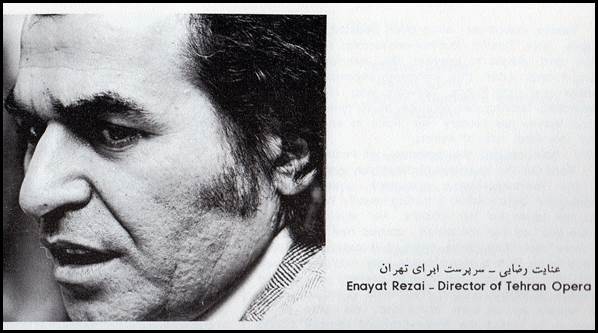
(Enayat Rezai - Director of Tehran Opera. Source: The Roudaki Hall Almanac, 1975-1976. Courtesy Liliana Osses Adams)
Notes on Roudaki Hall in Tehran, Iran – A Celebration of Opera by Liliana Osses Adams
Encouraged by the continuous support of Rudi van den Bulck, Founding Editor of Opera Nostalgia, I am humbled and privileged to present the virtually unknown Director Enayat Rezai of the Roudaki Hall Opera House in Tehran, once existing in its glory. By remembering the past, like it was yesterday, there will be chapters to write on those stories yet to emerge.
ENAYAT REZAI - Director of Tehran Opera
The Tehran Opera in Iran, formerly known as Roudaki Hall, was taken over in 1967 by its first Director, Enayat Rezai, who we belatedly recognize along with the Imperial Opera under the patronage of Her Majesty Empress Farah Pahlavi.

(Enayat Rezai - Director of Tehran Opera. Source: The Roudaki Hall Almanac, 1975-1976. Courtesy Liliana Osses Adams)
In 1956 The Shah of Persia, Mohammad Reza Pahlavi and Queen Soraya arrived in Turkey on an official state visit in Ankara. For this occasion, the Ankara Delvet Music Conservatory prepared a special ceremonial student concert welcoming Their Majesties. At that time, for a 21-year-old Enayat, it was beyond his dreams that it wouldn’t be long, until being appointed the Opera Director in Tehran, where he would shape the Company’s artistic output while distinguishing himself as an energetic administrator and critically acclaimed stage producer.
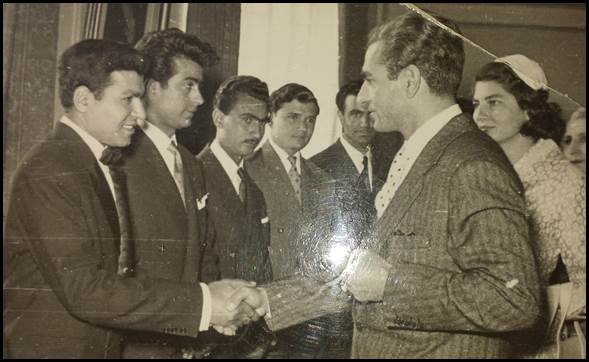
(H.I.M. the Shah of Persia and Queen Soraya (born Soraya Esfandiary Bakhtiari) greets Enayat Rezai after his performance of ‘To Bio’ (Come to me), a Persian folk song from the Bakhtiari region, arranged by Armenian composer Rouben Gregorian. Devlet Music Conservatory, Ankara, 1956.Photo property of Enayat Rezai)
Enayat (Enayatollah) Rezai was born on 23rd April 1935 in Manama, Bahrain, into the family of Iranian origin with a long tradition in Arabia, dating back over a century and half.
In the mid-1800s, Zainal Alireza, a boy about twelve years old, endured the hardship of the road on his journey all the way from Iran to Jeddah, on the Arabian shore of the Red Sea. His father Alireza, who lived in a southern town, not far from the port of Bandar-e Lengeh, was the owner of a caravan of camels and had married Um Ali bin Alireza, the governor’s daughter. One day, because of political and religious quarrels, his son Zainal was kidnapped, thrown into prison and shortly escaped through a tunnel dug under the walls by his father. He then sailed to Jeddah and began his business as food and cloth importer. He was doing well enough to bring his three younger brothers Ali Akbar, Haji Abdullah, and Hussein to Jeddah; before long they were engaged in trade and shipping generated by the annual Muslim pilgrimage to Mecca (Makkah) and Medina (Madinah) with thousands of Hajjis (pilgrims) coming by sea or crossing the land in caravans. The Alireza brothers’ descendants eventually split into four separate branches.
The oldest branch of the Alireza family (related to Enayat Rezai from Ali Akbar Alireza direct lineage) settled in Saudi Arabia and Bahrain and become one of the wealthiest and most affluent families in the Middle East (known as The House of Alireza, founded by Zainal Alireza), being merchants, industrialists, contractors, businessmen, and also humanitarians, philanthropists and diplomats; thus including Enayat’s prominent great-grand uncle, Haji Abdullah Alireza, his brother and Enayat’s great-grand father, Ali Akbar Alireza, his grandfather, Abdulghaffar Alireza, and his father, Mohamed Rafi Rezai/or Rezae (also known as Mohamed Rafi Alireza),
a prosperous drug merchant who travelled in neighboring Persian Gulf cities trading and distributing his products.
Enayat’s uncle, Abdullah Alireza (d. in 2004 in London) was educated at the elite English School of St. Xavier’s in Bombay and served as interpreter to the Saudi King, H.M. Abdul Aziz at the time when the first commercial cargo of Arabian crude oil was shipped from Ras Tanura Aramco refinery on May 1, 1939. Appointed the liaison officer for Aramco, he founded The Rezayat Company and today, almost 70 years later, the group has offices all over the world, headquartered in London, and presided over by his son, Teymour Alireza (b. 1939 in Jeddah), Enayat’s nephew and his childhood playmate in Tehran.
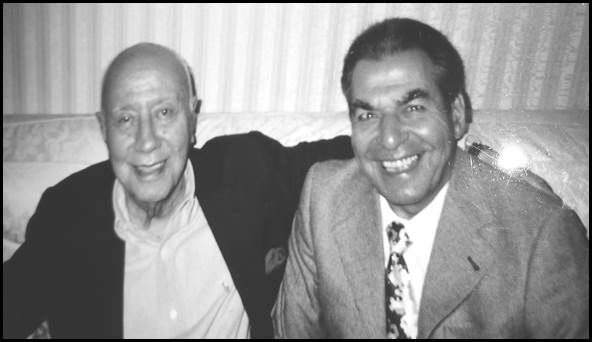
(Enayat’s uncle, Abdullah Alireza and Enayat Rezai during the visit in London, 1998. Photo property of Enayat Rezai)
In 1902 Abdul Aziz Ibn Saud (1876-1953) emerged from the Arabian Desert to take hold of the fortress in Riyadh, the main city of the surrounding region known as the Najd. Two decades later, the desert warrior and a chief of Bedouin raiders defeated the ruling Sharifian House on the coastal region of Hijaz (Hejaz) in Saudi Arabia.
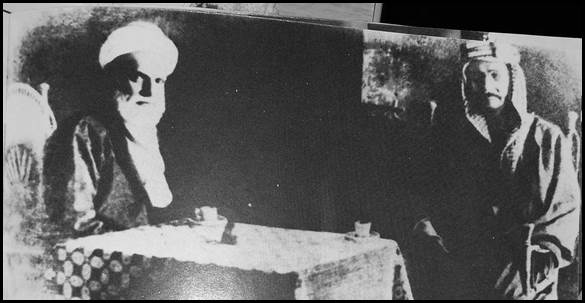
The governor of Jeddah, Haji Abdullah Alireza (pictured at left) regarded as the foremost figure in the negotiation with King Ibn Saud (pictured at right) surrendered of Hijaz on 25th December, 1925.
The photo was taken in 1925 by a photographer hired by Haji Abdullah Alireza.
Original source: Michael Field’s The Merchants: The Big Business Families of Arabia, pp.13-47 . Courtesy of Enayat Rezai
The two men sat under the tent in the gardens of the Kandarah Villa - now the site of the Kandarah Palace Hotel and drank the sweet Turkish coffee of the Hijazi (with a hint of cardamom and saffron) out of cups rather than the thick bitter Najedi black coffee out of little bowls as would have been customary in Riyadh. This ceremonial drinking of coffee became a symbolic welcome of the reasonable tolerant regime imposed by the Saudis after the siege of Jeddah by the zealous Wahhabi army, the Ikhwan warriors. When Ibn Saud, the Sultan of the Nejd rode into Jeddah on horseback wearing white turban rather than the traditional Arab kufiyah (roped head-cloth), he declared that the war between Najd and Hijaz was at the end. And then, Haji Abdullah Alireza handed over the keys of the city to the new ruler together with his own resignation. Ibn Saud responded by accepting the keys but refused the governor’s resignation, regardless that he had been a leader of the resistance and a fiery supporter of exiled Heshamite Sharif of Mecca and Emir of Hijaz, Hussein bin Ali (who had proclaimed himself Caliph, the leader of the Arab Muslim world on the fact that his family had descended from the Prophet Muhammad). Consequently with the conquest of the Hijaz and re-taking of the Holy Cities (which had been part of the Ottoman Empire for four centuries), Ibn Saud established a new political entity - the Kingdom of Najd and Hijaz, known as eponymous Kingdom of Saudi Arabia, formed in 1932 under the Wahhabi Sunni’s rule within Islamic law (Sharia) derived from the Koran.
By the early 1920s, Haji Abdullah, then the head (sheikh) of the Alireza household in Jeddah, had gained a concession, that would guarantee his brother’s son, Abdulghaffar (Enayat’s grandfather) the lucrative venture of pearl-fishing carried on from the shallow waters along the Iranian coast of the Persian Gulf and, particularly, around the islands of the Bahrain archipelago. Soon thereafter, he prospered as sales representative in Europe due to prolonged partnership on behalf of the Arabian pearl industry.
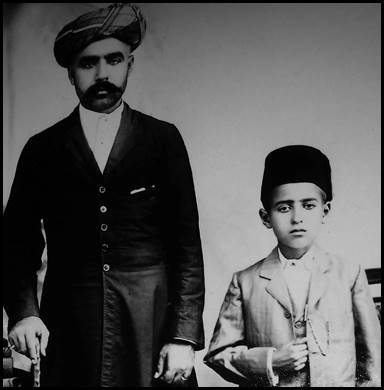
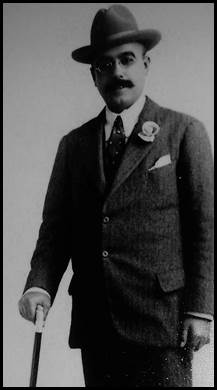
(Enayat’s grandfather, Abdulghaffar Alireza with his son, Mohamed Rafi, age 12 (Enayat’s father) + Abdulghaffar Alireza (pictured at right) in Paris, 1922. Photo courtesy of Enayat Rezai)
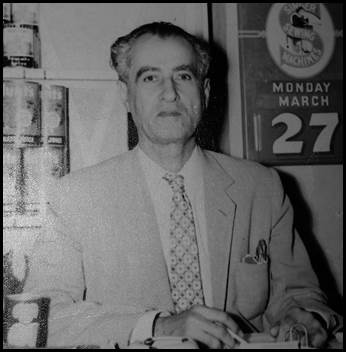
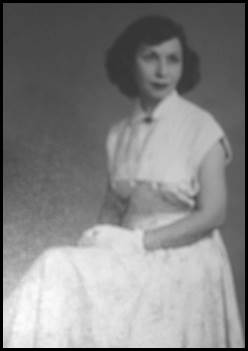
(Enayat’s father, Mohamed Rafi Rezai and Enayat’s mother, Fatima Jamal Khonji in Tehran, 1941 . Photo courtesy of Enayat Rezai )
Enayat’s father, Mohamed Rafi was born in Karmusta, southern province of Persia, and died in 1987 in Bahrain. He was married to Fatima Jamal Khonji, Enayat’s mother. She was born on 25th November 1904 in the southern harbor city of Bandar Lengeh, and died in 1997 in Bahrain.
Enayat Rezai is the youngest child among three brothers and a sister. In 2015 he celebrated his 80th birthday anniversary.
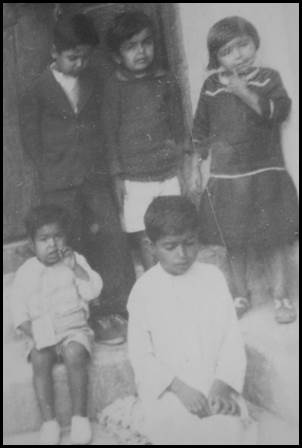
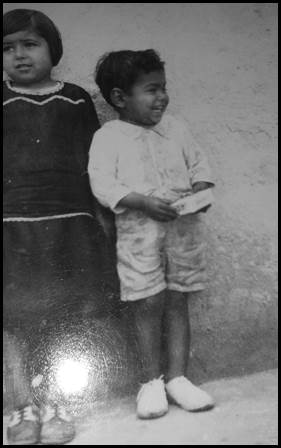
(Enayat (seated first on the left) with his four siblings and with his sister Noorangeez (on the right) + Manama, Bahrain, 1939. Photo courtesy of Enayat Rezai)
As early as he remembers, he was supposed to succeed as merchant but showed a penchant for singing by listening to the Persian songs sung by his mother who introduced him to music. Au fond he secretly dreamt to be an artist. In 1941 Enayat’s family moved to Tehran whilst his father developed his drug business. In the same time, Enayat, his sister and three brothers began their primary education in Tehran, where he joined the children’s choir and was taught to read music and sight-singing.
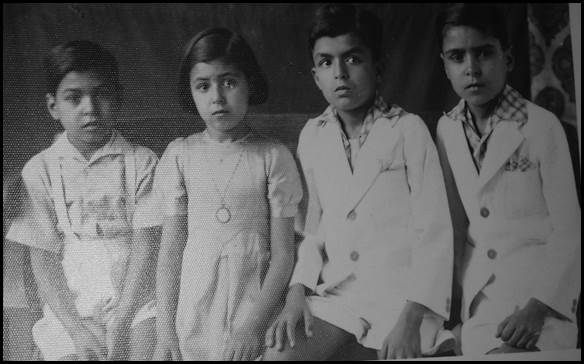
(Enayat (first at left) with his older siblings in Tehran, 1941. Photo courtesy of Enayat Rezai)
In 1953 Enayat Rezai finished his secondary education at the renowned Alborz College (formerly known as the American College of Tehran). At the same time, he sang in the Tehran Choir assembled by Evelyn Baghtcheban, Turkish mezzo soprano and chorus mistress (who came to Tehran with Samin Baghtcheban, Iranian composer, and whom she had married while studying in Ankara). During choral performances at various venues, he was chosen to sing solo parts with repertoire ranging from folk to classical music, conducted by Evelyn Baghtcheban. Very soon, she noticed his musical talents and natural vocal potentials and recommended him to Hikmet Şimşek, the instructor and conductor in the Ankara Conservatory, asking for Enayat’s audition. Meanwhile, his father would demand his return home, otherwise he wouldn’t receive his monthly allowance or any financial help. Determined to seek a voice teacher, he enrolled in the Ankara Conservatory and was invited to stay as guest in Hikmet Şimşek’s house. Good fortune followed him; he found very much needed work as librarian at the Iranian Embassy in Ankara, where he cataloged books in English and in Persian Alefba (Farsi alphabetical order). A few months later, he advanced as typist and had to write (with just one finger!) letters and some reports. At that time, the Consul General at the Embassy, Amir Abbas Hoveyda (who later became the Shah’s Prime Minister and was executed by firing squad in the wake of the Islamic Revolution) requested a scholarship for Enayat Rezai, which was granted to him by the Ministry of Culture in Tehran. In particular, Iran’s Ambassador to Turkey, General Hassan Arfa offered his assistance, following Enayat’s promising debut as Germont-père in Verdi’s Traviata. From now on, he was able to continue his further studies and to support himself financially.
In 1954 Enayat Rezai was admitted to the Department of Performing Arts at Devlet (“State”) Music Conservatory in Ankara, opened in 1935 under directives issued by Mustafa Kemal Atatürk (whose establishment of modern secular Republic of Turkey ended the Ottoman Empire ruled by Sultans and Caliphs). Following Atatürk’s far-reaching cultural reforms, Paul Hindemith was commissioned to restructure and modify the music departments at Devlet Conservatory while Carl Ebert (associated as director with the Glyndebourne Festival Opera) created the opera and drama programs that integrated into the faculty curriculum. Modeled on European music conservatories, the school adopted the Occidental octave system (in addition to the Anatolian 24-part chromatic scale or 17-tone Turkish octave), and introduced classical instruments, including harp. (One of the first departments of Music Teachers School was the Harp Department where many leading harpists of Turkey graduated). In 1982 the Conservatory had been affiliated with Hacettepe University and then was renamed Ankara Devlet Konservatuvari Hacettepe Űniversitesi).
Enayat Rezai’s first voice teacher in Ankara was the great Italian baritone, Apollo Granforte.
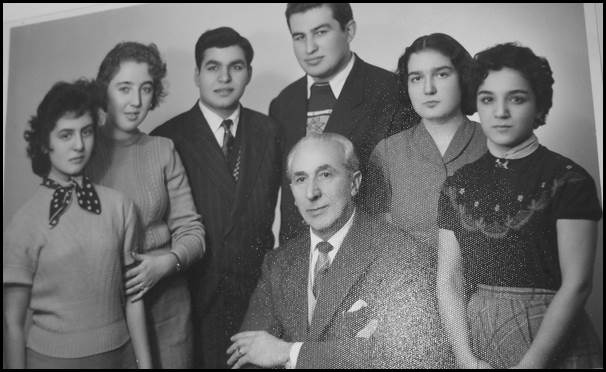
(Master teacher, Apollo Granforte seated in the center amongst his students and Enayat Rezai (standing third from the left), Devlet Music Conservatory, 1955. Photo courtesy of Enayat Rezai)
Soon after, Apollo Granforte left his teaching position at Devlet Conservatory. On his departure, he signed the photograph dedicated to Enayat Rezai, dated December 30, 1955. However, the opera classes at the Conservatory continued under another leading Italian baritone, Carlo Galeffi.
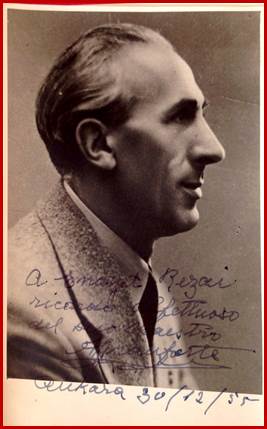
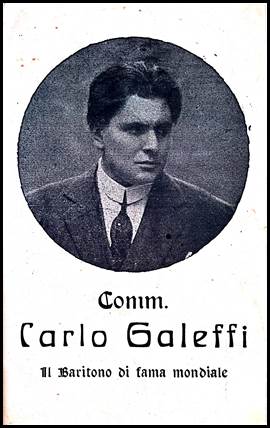
(Apollo Granforte dedication to Enayat Rezai, Ankara, December 30, 1955, and the cover page of Carlo Galeffi’s program (at right). Photo property of Enayat Rezai)
At summer breaks, Enayat Rezai, active as he was, participated at training camps in music, dance, drama, and opera promoted by the International Red Cross in Istanbul.
His actual relationship with drama theatre began as supernumerary soldier in theatrical presentation of Shakespeare’s “Hamlet” at the Great Theatre of Ephesus during the ancient city’s Festival of Culture and Art.
On May 15, 1957, the performance of Verdi’s “La Traviata” at Devlet Music Conservatory, attended by the Ambassador Hassan Arfa and his wife, Hilda Bewicke was recognized as yet another admirable success by the young singers and their teacher, Professor Carlo Galeffi. Maestro Clemente Di Ferdinando conducted the faculty orchestra.
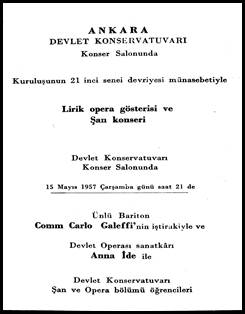
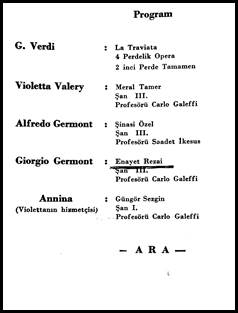
(Program of Verdi’s La Traviata at the Ankara Devlet Conservatory, May 15, 1957)
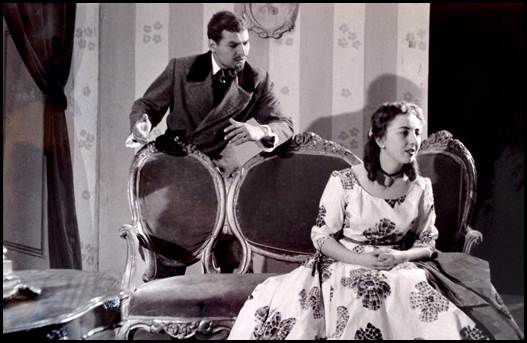
Enayat Rezai as Giorgio Germont and Meral Tamer as Violetta
Verdi’s La Traviata, Act III, performed by the pupils of Carlo Galeffi
Ankara Devlet Conservatory, May 15, 1957. Photo courtesy of Enayat Rezai
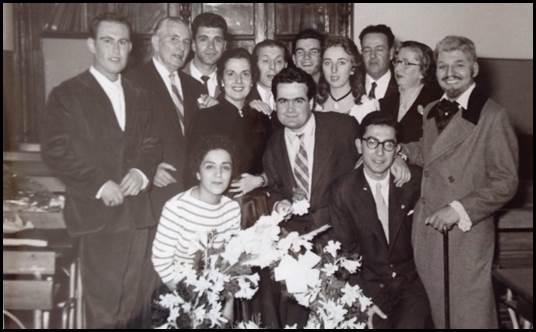
Carlo Galeffi (standing second left) with his students after the premiere of Verdi’s La Traviata. Ankara Devlet Conservatory, May 15, 1957. Photo courtesy of Enayat Rezai (first at right)
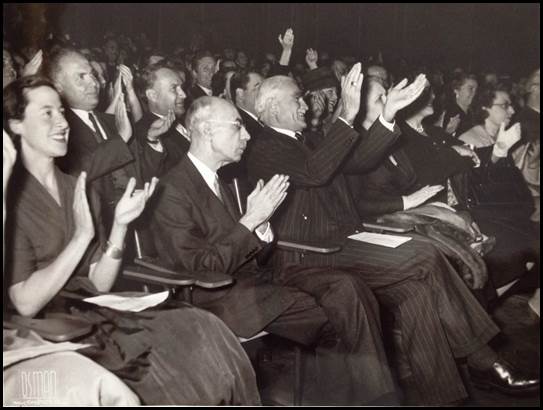
(Enthusiastically applauding audience at Devlet Music Conservatory, Ankara, 1957
First row from the left: Hilda Bewicke (Mrs Arfa), the Ambassador Hassan Arfa, and unknown by name Italian ambassador. Photo courtesy of Enayat Rezai)
This rare photo of the Ambassador Hassan Arfa and his wife Hilda Bewicke, a former British ballerina of Diaghilev’s Ballets Russes, was taken in 1957. For those interested please read: an autobiography ‘Under Five Shahs’ by General Hassan Arfa, and Saideh Pakravan’s memoires ‘Fridays at Larak’ on General Arfa’s family and her aunt Hilde Bewicke during the author’s visits at Larak, the Arfa’s estate to the north of Tehran.
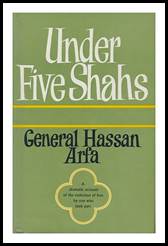
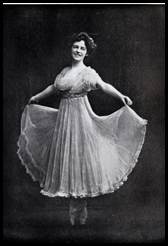
(General Hassan Arfa’s autobiography, John Murray Ed., London, 1964 Hilda Bewicke in gracious dance pose, Queen’s Gate School, London, 1900’s)
In 1959 Enayat Rezai continued his youth experiences as Tonio in Leoncavallo’s “Pagliacci”, singing in front of the curtain: Si può? Si può? Signore! Signori! Scusatemi se da sol mi presento. Io sono il Prologo…
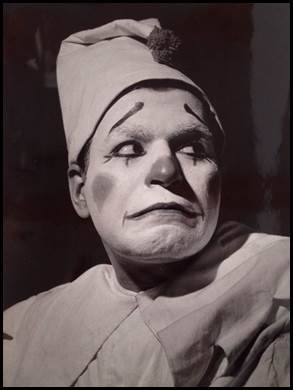
Enayat Rezai as Tonio in Leoncavallo’s Pagliacci
Ankara Devlet Conservatory, 1959. Photo courtesy of Enayat Rezai
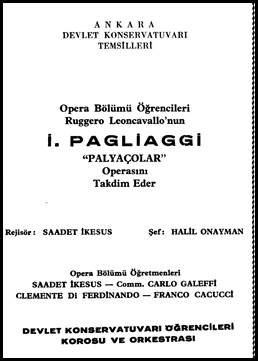
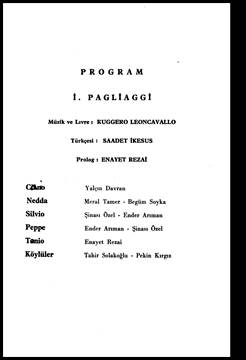
(Program of Leoncavallo’s Pagliacci at Ankara Devlet Conservatory, 1959)
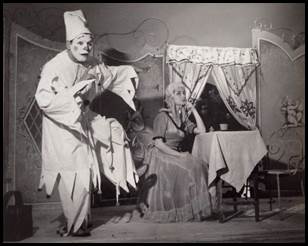
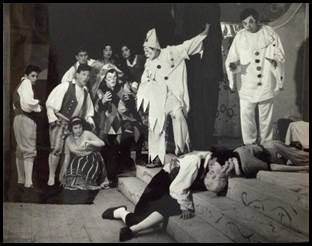
Enayat Rezai as Tonio and Meral Tamer as Nedda, incl. Ensemble final scene of ‘I Pagliacci’ (at right)
Ankara Devlet Conservatory, 1959. Photo courtesy Enayat Rezai
On 24th February 1960, Enayat Rezai and Meral Tamer appeared in Tehran in duo-recital “Concert de Chant” with program of Mozart, Beethoven, Puccini, Rossini, and Verdi, accompanied on piano by Carmen Ossorio (the future correpetitor at Roudaki Hall). The performance at Ferdowsi Theater was sponsored by the Beaux-Arts administration.
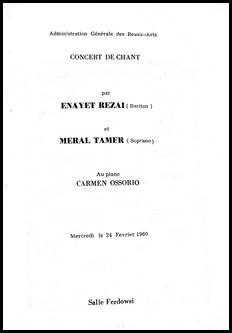
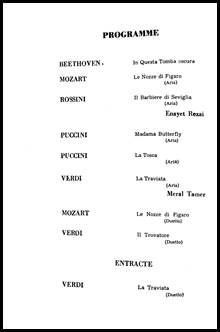
(Program of Concert du Chant performed by Enayat Rezai and Meral Tamer Ferdowsi Theater, Tehran, 1960. Courtesy of Enayat Rezai)
In June 1960 Enayat Rezai earned his Bachelor’s degree under the guidance of Carlo Galeffi at Ankara Devlet Conservatory, where he had been trained in both vocational and cultural competence.
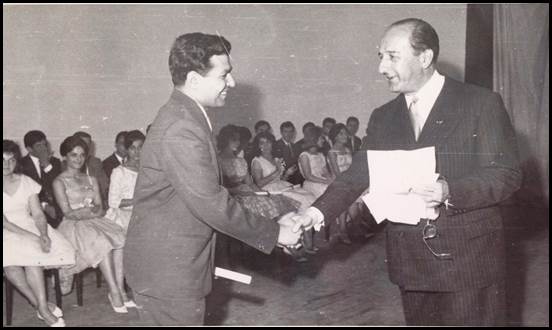
(Enayat Rezai receiving his Bachelor’s diploma in vocal arts from the Dean of the Faculty Ankara Devlet Conservatory, 1960. Photo courtesy of Enayat Rezai)
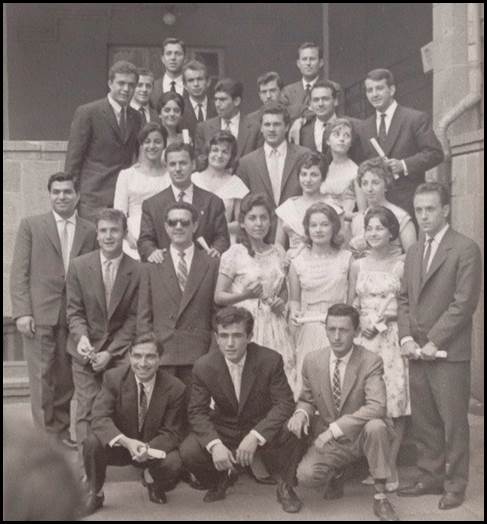
(Conservatory Graduates and Enayat Rezai (second row standing from the left) Devlet Conservatory, Ankara, 1960. Photo courtesy of Enayat Rezai)
Immediately after Enayat’s 1960 graduation, he was invited by Director Vedat Gürten to become a soloist at the Ankara Devlet Opera and Ballet. Therefore, as an aspiring and ambitious singer, he wanted to improve his singing and he continued to seek further vocal coaching to hone his skills, extend his vocal range and learn new styles. After all, he perfectly knew, that the process of studying does not end after an initial diploma or degree.
Later that year, Enayat Rezai departed for Europe. On arrival in Italy, he was coached by Toti Dal Monte in vocal technique and interpretation at the “Benedetto Marcello” Conservatory of Music in Venice (Conservatorio di Musica Benedetto Marcello di Venezia) under direction of Renato Fasano, where he understudied the leading bass role of Bernardone in two-act dramma giocoso by Domenico Cimarosa’s “Giannina e Bernardone”.
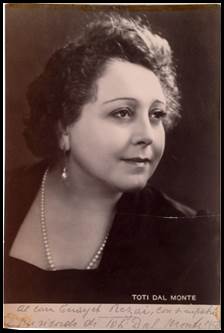
(Toti Dal Monte dedication to Enayat Rezai, Venice, 1960 Photo property of Enayat Rezai)
In the year that followed, he perfected his voice and learned new Italian repertoire during Master Classes with Mario Basiola (another Italian operatic baritone between two wars, now forgotten) at his famous Opera School in Milan, founded in 1952 with his wife, Italian soprano, Caterina Gobbi.
Enayat Rezai’s rare opportunity and completely new theatrical experience began at the Piccolo Teatro di Milano, created in 1947 by Giorgio Strehler and Paolo Grassi under the slogan Teatro d’Arte per Tutti. At the immediate postwar years, modern Italian theatre underwent many changes, pushed along by the new idea of teatro stabile (in contrast to the itinerant troupes that crisscrossed the country) and had been shaped by foreign influence in both contemporary and classical repertory, and by the epic theatre of Berthold Brecht. The longtime Superintendent of La Scala, Dr. Antonio Ghiringhelli facilitated Enayat’s participation in Giorgio Strehler’s lengthy preparatory rehearsals for the upcoming 1963 production of Brecht “Threepenny Opera” with Mario Carotenuto as Peachum (who reprised the role from the 1956 premiered production in Milan in the presence of the author, Berthold Brecht). These earlier productions of Brecht with music by Kurt Weill were repeated at “Piccolo” during Giorgio Strehler and Milva’s recital, entitled “Io, Berthold Brecht” (in 1966), and again with Milva (dubbed as Strehler’s muse) in the role of Jenny with Domenico Modunio as Mackie Messer (in 1973).
Through the years, Enayat Rezai became more confident to express himself publically. In October 1961 he enrolled (under his given name Enayatollah) in the Hochschule für Musik in Munich (Hochschule für Musik und Theater München), after passing an audition of artistic proficiency and a test for sufficient knowledge of German. In addition to his voice studies under tutelage of Professor Karl Schmitt-Walter, he took the courses of Drama and Opera Direction under Professor Heinz Arnold. In June 1963 he completed his postgraduate studies in Munich.
In 1962 he sang the role of Fisher in one-act opera of Heinz von Cramer’s “Die Flut”, composed by Boris Blacher, under musical direction of Erich Bohner, and in stage production by Heinz Arnold, performed at Gärtnerplatz Theater in Munich.
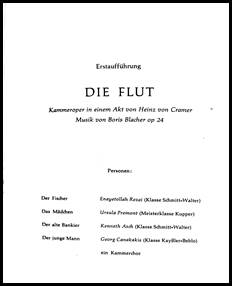
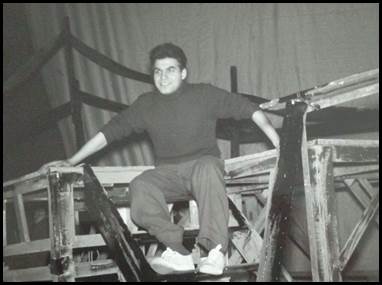
(Boris Blacher’s Die Flut, Gärtnerplatz Theater, Hochschule für Musik, Munich, 1962 Enayat/ Enayatollah Rezai as Fisher. Courtesy of Enayat Rezai)
In 1963 he sang the role of Johann in one-act opera buffa by Albert Lortzing’s “Die Opernprobe” in stage direction by Heinz Arnold, under the baton of Erich Bohner at Gärtnerplatz Theater in Munich.
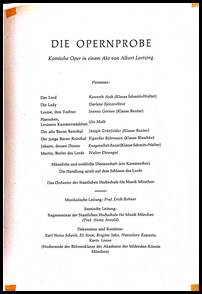
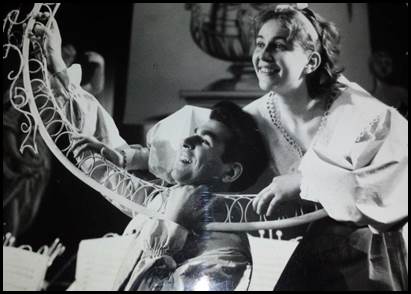
(Albert Lortzing’s Die Opernprobe, Gärtnerplatz Theater, Hochschule für Musik, Munich, 1963 Enayat/ Enayatollah Rezai as Johann and Ute Maik as Hannchen. Courtesy of Enayat Rezai)
On May 26, 1963, the Staatliche Hochschule für Music in München (Abteilung Oper) presented Opermatinee at Staatstheater am Gärtnerplatz Theater of “Gianni Schicchi” by Puccini in stage direction of Heinz Arnold with Enayat/Enayatollah Rezai in the title role. The highly-praised diploma performance led to his further engagements as soloist in Gelsenkirchen Musiktheater.
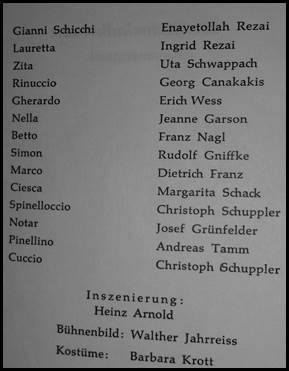
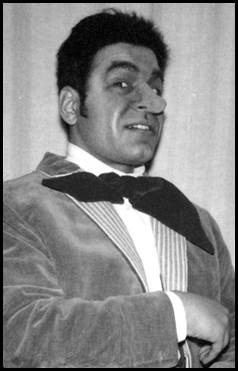
(Puccini’s Gianni Schicchi, Gärtnerplatz Theater, Hochschule für Musik, Munich, May 26, 1963, Enayat/Enayatollah Rezai as Gianni Schicchi. Courtesy of Enayat Rezai)
During the six years (from 1959 to 1965), Enayat Rezai participated at Weikersheim’s Summer Program organized by Jeunesses Musicals Deutschland for Young Opera under direction of Fritz Büchtger, composer and lecturer on anthroposophical music at Rudolf Steiner’s Goetheanum in Dornach, Switzerland. On September 16, 1959, during the final double cast student’s performance of Mozart’s “The Marriage of Figaro”, produced by Martin Volkmann, under the baton of Klaus Bernbacher, Enayat Rezai sang the role of Almaviva (act 3 and 4), opposite Irene Robinson as Susanna (act 3 and 4.)
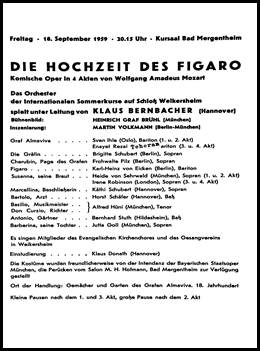
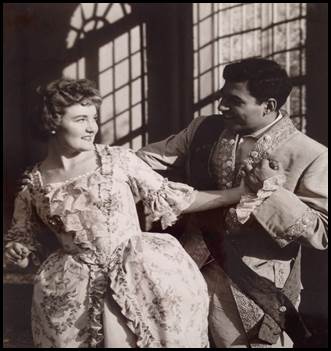
(Mozart’s The Marriage of Figaro at Weikersheim, September 16, 1959 +Enayat Rezai as Almaviva and Irene Robinson as Susanna (in act 3 and 4) Courtesy of Enayat Rezai)
During the summer of 1961, Enayat Rezai had been invited to Weikersheim, where he was cast as Guglielmo in the final student’s production of Mozart’s “Cosi fan tutte”, conducted by Klaus Bernbacher and produced by Martin Volkmann.
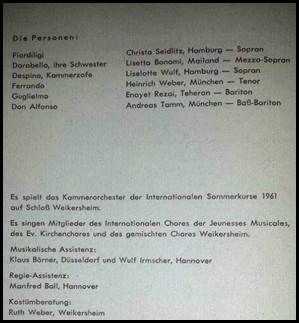
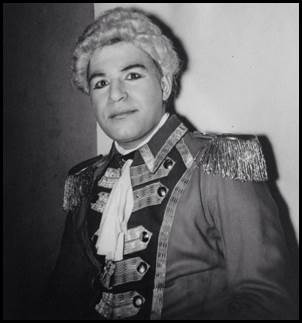
(Enayat Rezai as Guglielmo in Mozart’s Cosi fan tutte at Weikersheim, September 2, 1961 Courtesy of Enayat Rezai)
On August, 31, 1964, Enayat Rezai appeared again at Weikersheim, where he sang the leading role of Figaro in Rossini’s “The Barber of Seville”, produced by Siegfried Grote, under musical direction of Klaus Bernbacher.
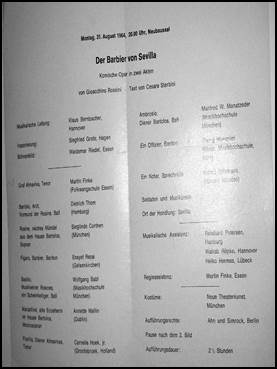
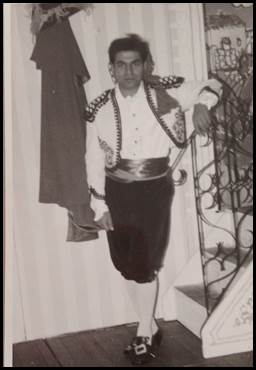
(Enayat Rezai as Figaro in Rossini’s The Barber of Seville at Weikersheim, 1964 Courtesy of Enayat Rezai)
During summer of 1965, Enayat Rezai sang the role of Don Fernando in the Weikersheim production of Beethoven’s “Fidelio”, conducted by Klaus Bernbacher, in stage direction by Siegfried Grote.
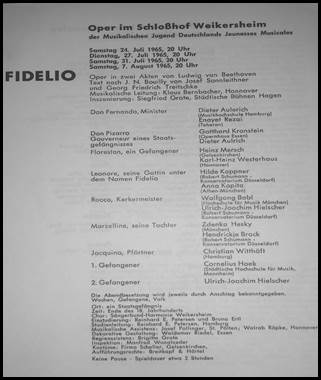
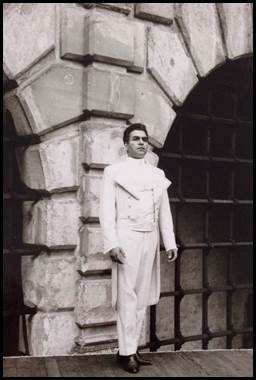
(Enayat Rezai as Don Fernando in Beethoven’s Fidelio, Weikersheim, July-August, 1965 Courtesy of Enayat Rezai)
Meanwhile, the most unexpected invitation came by the personal letter from His Excellency, Mehrdad Pahlbod, Minister of Culture and Arts in Iran. On March 18, 1961, in the presence of Their Imperial Majesties, Enayat Rezai, while still a student, had made his operatic debut as Rigoletto and also as stage director in Tehran’s production of Verdi’s “Rigoletto” at the old Farhand Hall, under the baton of Heshmat Sanjari with the Tehran Symphony Orchestra. The performance included Enayat Rezai/Hossein Sarshar (double casting) as Rigoletto, Farah Afiatpour as Gilda, Ahmad Parsi as the Duke, and Manouchehr Vaziri as Monterone. In coming years, he moved constantly between Munich and Tehran and then Gelsenkirchen and Tehran.
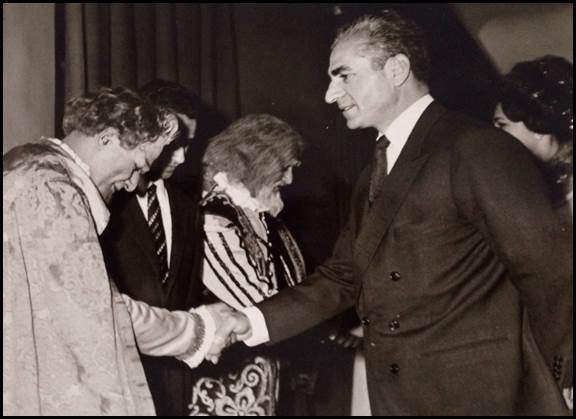
Mohammad Reza Shah Pahlavi greets the artists after the performance of Verdi’s Rigoletto
From the left: Hossein Sarshar, Enayat Rezai and Manouchehr Vaziri.
Farhang Hall, Tehran, March 18, 1961. Photo courtesy of Enayat Rezai
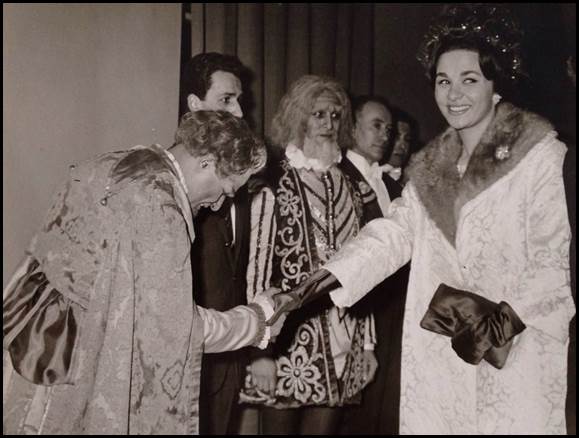
Farah Pahlavi the Queen of Iran greets the artists after the performance of Verdi’s Rigoletto
From the left: Hossein Sarshar, Enayat Rezai, Manouchehr Vaziri, and Heshmat Sanjari.
Farhang Hall, Tehran, March 18, 1961. Photo courtesy of Enayat Rezai
From September 1963 to May 1967, Enayat Rezai was listed on the roster in Gelsenkirchen Musiktheater im Rivier (the German region of Ruhr). At that time, he appeared, among others, as Guglielmo (Mozart Cosi fan tutte), Leonello (Franz von Suppé Boccaccio), Schlémil (Offenbach The Tales of Hoffmann), Apollo (Gluck Alceste), Yakuside (Puccini Madama Butterfly), Homonay (Johann Strauss, II The Gypsy Baron), Raoul de St Brioche (Lehár The Merry Widow), and as “Muff”, an Indian (Smetana The Bartered Bride).
Selected photos of Enayat Rezai performances at Gelsenkirchen
Courtesy of Enayat Rezai
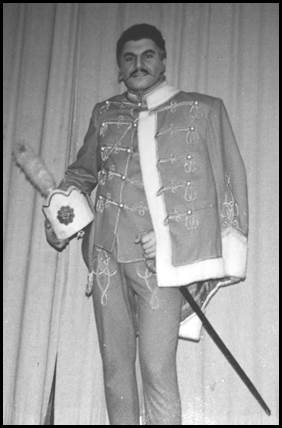
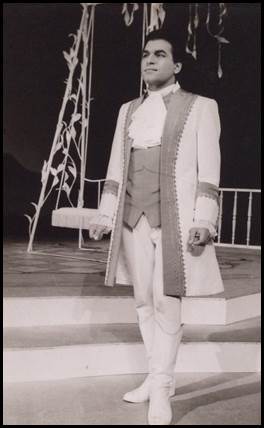
Enayat Rezai as Homonay (Gypsy Baron), 1963; Enayat Rezai as Guglielmo (Cosi fan tutte), 1964
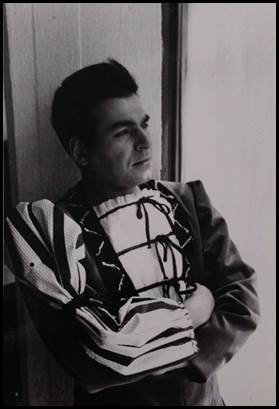
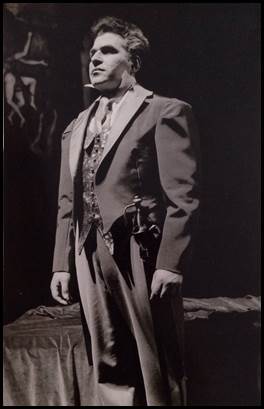
Enayat Rezai as Leonello (Boccaccio), 1965; Enayat Rezai as Schlémil (Tales of Hoffmann), 1965
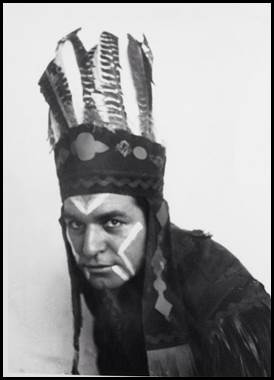
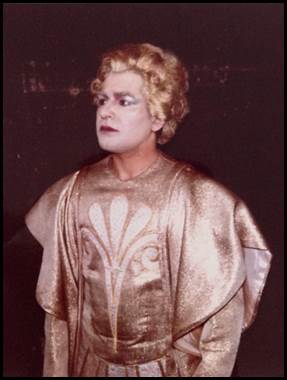
Enayat Rezai as Muff (Bartered Bride), 1966; Enayat Rezai as Apollo (Alceste), 1965
At that time of his career, he began a new artistic phase as an assistant stage producer to the renowned director, Günter Roth with whom he had studied in the opera department at Folwang University of Arts (Folwang Universität der Künste) in Essen. In 1966, the Gelsenkirchen production of Paul Hindemith’s highly regarded work “Harmony of the World,” in abridged version authorized by the composer, was directed by Günter Roth in staging assistance by Enayat Rezai with sets designed by Dominik Hartmann, and under the musical direction of Ljubomir Romansky. The featured cast included Jef Vermeersch in the lead role of Johannes Keppler, the astronomer, personified the Earth and Ursula Schrӧder-Feinen as Keppler’s wife, the planet Venus. The opera took its title from Johannes Keppler’s 16th century theoretical work “Harmonices mundi”. Enayat Rezai’s other Gelsenkirchen experiences as assistant stage producer included Puccini’s “Tosca”, Verdi’s “Nabucco”, and Richard Strauss’s “Ariadne auf Naxos”.
In February 1967 Enayat Rezai was again invited by Minister Pahlbod to come to Tehran. He was asked to direct another opera with only Iranian artists to ensure that this ensemble would be ready to perform during the coronation ceremony of Their Imperial Majesties, coincident with the inaugural of the Roudaki theatre, scheduled for upcoming October.
After one month of rehearsals, Enayat Rezai stage production of Mozart’s “Cosi fan tutte” was presented in the Ministry of Fine Arts Grand Hall in March 1967 featuring the strong cast of Iranian singers, led by Hossein Sarshar as Guglielmo, Monir Vakili as Fiordiligi, Evelyn Baghtcheban/Fakhereh Saba (double casting) as Dorabella, Nassrin Azarmi/Mansoureh Ghasri (double casting) as Despina, Ahmad Parsi as Ferrando, and Enayat Rezai as Don Alfonso. Heshmat Sanjari was on the podium with the Tehran Symphony Orchestra. Enayat Rezai’s stage production of Mozart’s Cosi - one of the most difficult operas to direct because of its emotional complexity, resulted with the request of his almost immediate return to Tehran and the cancelation of his engagement in Gelsenkirchen in May 1967.
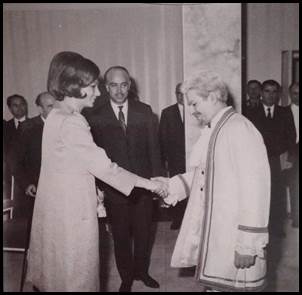

H.I.M. Farah Pahlavi conversing with Enayat Rezai after the performance of Mozart’s Cosi fan tutte
At the center: Mehrdad Pahlbod and Amir Abbas Hoveyda (less visibly standing behind at the left)
Ministry of Fine Arts Grand Hall, Tehran, March 1967. Photo courtesy of Enayat Rezai
In August 1967 upon his return to Tehran, Enayat Rezai was chosen for the directorial position with full responsibility to supervise the artistic programming and administrative and technical staff for the ceremonial opening of the Roudaki theatre.
On 26th October 1967, the day of the coronation ceremony at Golestan Palace, Mohammad Reza Shah Pahlavi (1919-1980) had crowned himself on his 48th birthday. After twenty-six years into his reign as the Shah (“King”) he took his imperial oath along with the title of Shahanshah - the Emperor or the King of Kings, belonging to the founder of Achaemenid Persian Empire, Cyrus the Great. A few minutes later, his consort, Farah Diba had been crowned Shahbanou, the Empress by her husband, who put the crown gently on her head. The Shah thought of himself as heir to the ancient kings of Persia. In 1971 he held the celebration of the twenty-fifth centennial of the monarchy at the ruins of Persepolis. Starting earlier in the 1960s, the Shah’s immortal desire to create the powerful and modern Iran with strong ties to its history, rich heritage and religious identity were viewed by the Shiite Muslim clerics, the Mullahs, as anti-Islamic, and therefore resulted in the overthrow of the Pahlavi dynasty (1925-1979), founded by Reza Shah Pahlavi.
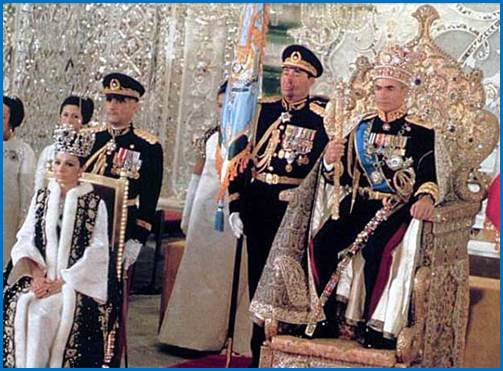
In this official photograph commemorating the coronation ceremony, the Emperor Mohammad Reza Pahlavi in gem encrusted regalia sits on the Peacock Throne while Empress Farah, wearing the Pahlavi crown, is seated beside her husband. Golestan Palace, Tehran, October 26, 1967.
Pictured: Empress Farah, the Shah, and General Abdol Ali Badrei (standing left behind the Shah).
His death has become a mystery. On February 10, 1979, Abdol Ali Badrei had led the Imperial Guard in a military coup to overtake the capital and to prepare and facilitate the return of the Shah on the throne. The next day, he was assassinated by a revolutionary guard or by one of his solders or by a foreign military officer?
At the newly constructed Roudaki Hall in Tehran, the main iron curtain at the proscenium displayed the Persian motif of Simurgh, a colorful winged creature in the shape of a bird rising from the ashes, like a phoenix.
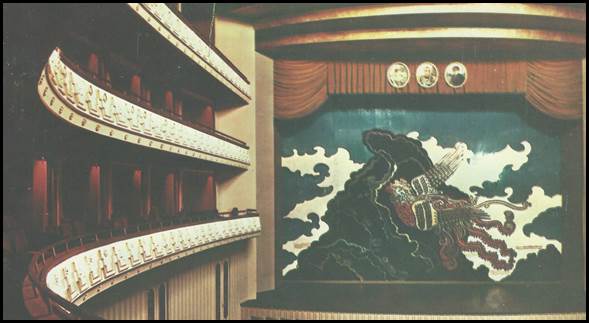
The figurative motif of Simurgh decorated the iron curtain at the proscenium, Roudaki Hall, Tehran
Liliana Osses Adams collection
During the Gala Evening at the Imperial Opera in Tehran, in attendance by Their Majesties and their princely guests, the performance of the commissioned opera in one-act “Zal and Roudabeh”, originally composed for piano by Samin Baghtcheban (orchestrated by Cezar Bergsen) captivated the audience. Directed by Monir Vakili, the epic tale of love, compassion, and destiny from Ferdowsi’s the “Shahnameh” (The Book of Kings) was adapted by poet Ahmad Shamloo. Staged into two beautiful ballet tableaux with scenery designed by Theo Lau, choreographed by Robert de Warren and Aida Ahmadzadeh, the production cast featured Evelyn Baghtcheban as soloist with chorus singing the Ferdowsi verses backstage and two actors, Bahman Mofid and Afsaneh Deyheem, mime on the stage. The eminent conductor, Heshmat Sanjari was on the podium with the Tehran Symphony Orchestra.
The famous Persian tale of Zal and Roudabeh begins with the birth of the mythical hero-warrior, Prince Zal. Born albino he was rejected by his father. Ashamed of his son’s strange look, he abandoned the crying baby at the foothills of the bejeweled Alborz Mountain where he was found by Simurgh, a bird dripping in multicolored feathers who had many fantastic and supernatural powers, including gifts of speak and foresight. Inspired with deep feeling of love, protection and mercy, she took him into her nest near the sun and far away from human beings, and raised him as her own in the branches of the Tree of Life, which contained the seeds of the elixir of immortality. Over the years, as the boy grew to be a youth full of strength, the bird urged him to part “to see what fate has in store” for him. She gave him the magical feather to burn if he were ever in danger and needed help. Wandering from place to place, he fell in love with and married Princess Roudabeh, daughter of the king of Kabul. When it came time for Roudabeh to give birth to their child, she was in great pain, near death, due to the large size of the baby. Remembering the Simurgh, he burnt the feather and the bird appeared in a giant cloud. She instructed him upon how to perform Rostam-zad (referred by Ferdowsi as Caesarean section) through an incision with the bird’s feather. Thus saved mother and child. They named him Rostam, meaning “god saved”, who was to be a mighty warrior of great strength, a titan as Hercules.
Contrasting with the pre-Islamic tale, the one-act contemporary story “The Peasant Feast” (Jashne Dahguan) composed by Ahmad Pejman was equally spectacular with narrative, rhythm and visual sounds. The production staged by Enayat Rezai in a set designed by Theo Lau, based on the libretto by Manouchehr Sheibani was inspired by the economic growth launched by the Shah during the 1960s White Revolution. The peasant couple remembered the villagers old day’s sufferings. And then, everybody was happy; the rural roads, homes, and schools were built, the land was distributed, electrified and irrigated, the health care was provided and the living standards were improved. The featured cast included Hossein Sarshar as The Old Man, Soudabeh Tadjbakhsh as The Old Woman, his wife, Vahideh Fatourechi as their Daughter and Ahmad Parsi as their Son. Heshmat Sanjari conducted the Tehran Symphony Orchestra with chorus prepared by Evelyn Baghtcheban and Alfred Mardoyan.
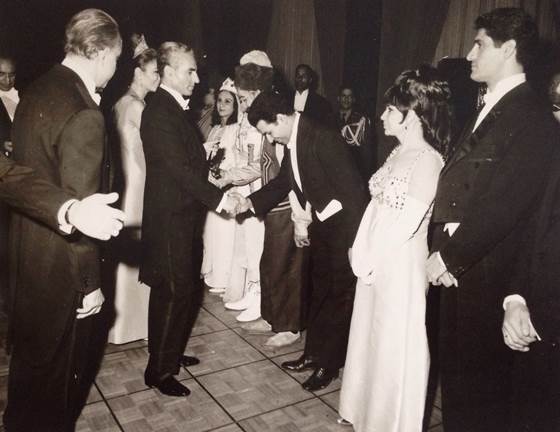
H.I.M. the Shah of Iran and Empress Farah Pahlavi receiving the artists in private audiences
From the right: Ahmad Pejman, Monir Vakili, Enayat Rezai, Hossein Sarshar, Bahman Mofid, and Afsaneh Deyheem (fourth and fifth less visibly). Inauguration of Roudaki Hall, Tehran, October 26, 1967. Photo courtesy of Enayat Rezai
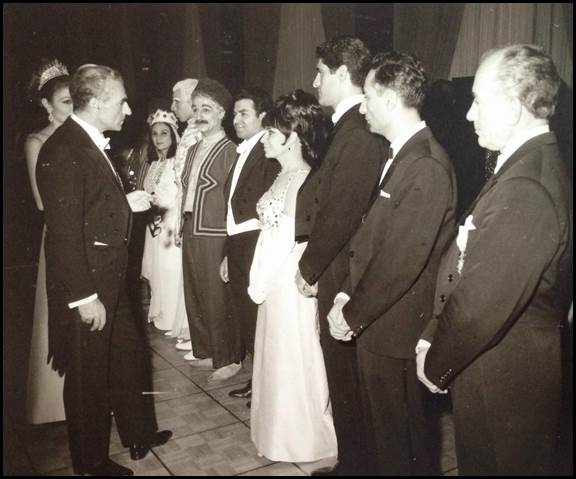
H.I.M. the Shah of Iran and Empress Farah Pahlavi receiving the artists in private audiences
From the right: Heshmat Sanjary, Alfred Mardoyan, Ahmad Pejman, Monir Vakili, Enayat Rezai, Hossein Sarshar, Bahman Mofid, and Afsaneh Deyheem.
Roudaki Hall, Tehran, October 26, 1967. Photo courtesy of Enayat Rezai
During the reception, Empress Farah posed the following question: Would you like to help us to continue as you have helped us to begin? Through the patronage of Their Majesties and, in particular, H.I.M. Empress Farah, the International Shiraz Arts Festival was held annually at the spectacular ruins of Persepolis. In October 1988 the annual Festival of Culture and Arts was also inaugurated at Roudaki Hall, marking the brilliant opening of the artistic season with Enayat Rezai’s production of two-act opera by Ahmad Pejman’s The Hero of Sahand (Delavareh Sahand), based on the libretto by Dr. Saadi Hassani and Manouchehr Sheibani. Hossein Sarshar in the leading role gave an ardent portrayal of a Zoroastrian freedom fighter, Babak Khorramdin, born in the Sahand region who became a commander of the entrenched stronghold at Babak Castle in Azerbaijan and fought not only against the Caliphate and governance under Islamic law, but also for the preservation of Persian language, culture and religion.
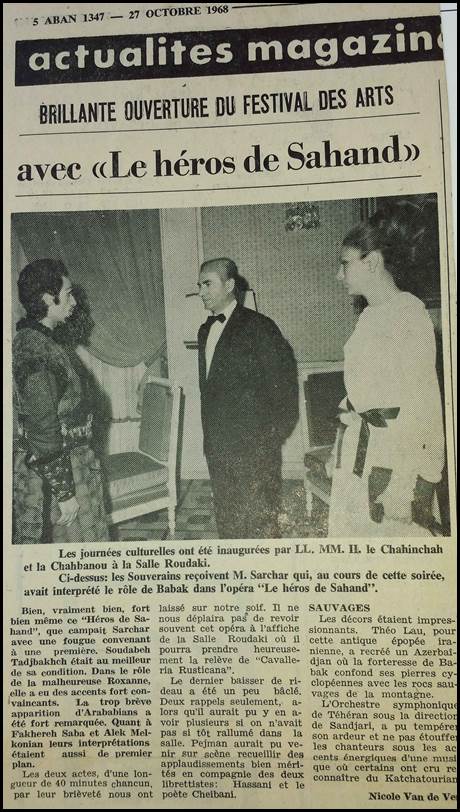
The article of Nicole Van de Vert on the inauguration of the Festival of Culture and Arts
Roudaki Hall, Journal de Téhéran, October 27, 1968
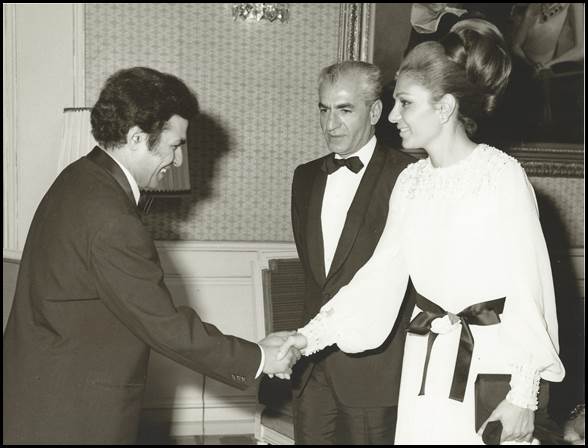
H.I.M. the Shah and Empress Farah greets Enayat Rezai after the premiere of The Hero of Sahand
Roudaki Hall, Tehran, October, 1968. Photo courtesy of Enayat Rezai
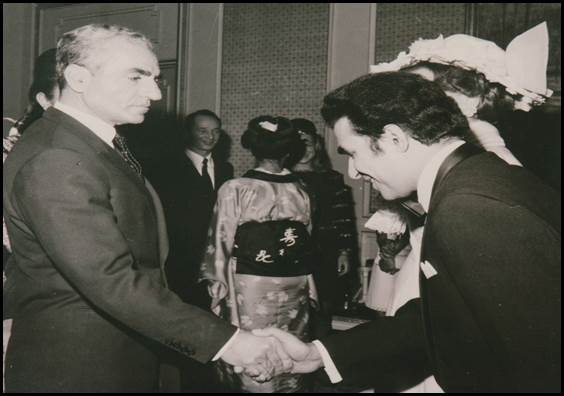
H.I.M. the Shah greets Enayat Rezai and the opera ensemble of Puccini’s Madama Butterfly
The stage production by Yoshio Aoyama in 1971, assisted by Enayat Rezai, under the baton of Maestro Manrico de Tura, featured Monir Vakili as Cio-Cio-San, Carlo Piccini as Pinkerton, Enayat Rezai as Sharpless, Fakhereh Saba as Suzuki, and Ingrid Rezai as Kate Pinkerton.
Roudaki Hall, Tehran, 1971. Photo courtesy of Enayat Rezai

Their Majesties the Shah and Empress Farah conversing with Enayat Rezai and Hossein Sarshar
Enayat Rezai produced Verdi’s Rigoletto with Hossein Sarshar in title role at Roudaki Hall, 1971
Photo courtesy of Enayat Rezai

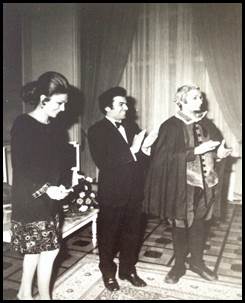
H.I.M. the Shah and Empress Farah receiving Enayat Rezai and Hossein Sarshar as Rigoletto
Roudaki Hall, Tehran, 1971. Photo courtesy of Enayat Rezai
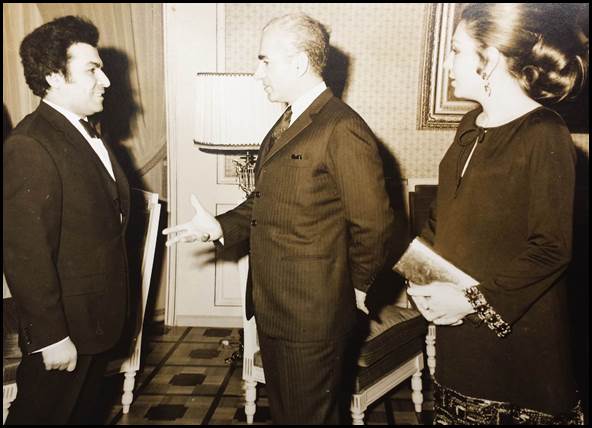
The Shah and Shahbanou conversing with Enayat Rezai after performance of Verdi’s Rigoletto
Roudaki Hall, Tehran, 1971. Photo courtesy of Enayat Rezai
At that time, Director Enayat Rezai saw a need and sought the possibility for a permanent opera orchestra; his proposal was taken into serious consideration between the parties involved and responsible for such a change. From then on, Enayat Rezai and Farhad Mechkat went to Europe seeking for musicians from mainly Eastern European countries. The complete opera orchestra of over sixty musicians was formally established under the baton of Maestro Manrico de Tura and took over the duties from the Tehran Symphony Orchestra under direction of an outstanding conductor, Farhad Mechkat. In 1972 I joined the opera ensemble as principal harpist and witnessed many unforgettable evenings at the theatre during the last six seasons of its artistic activities.
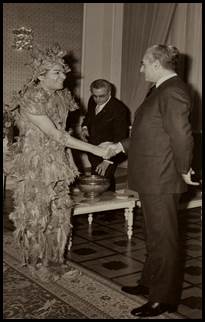
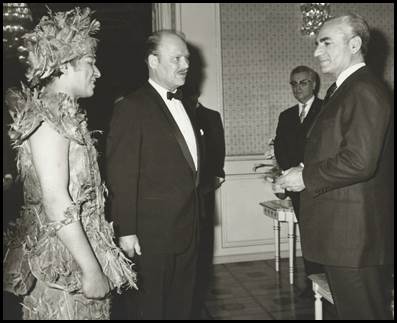
H.I.M. the Shah receiving Enayat Rezai as Papageno and Heinz Arnold, the stage producer (center)
Professor Heinz Arnold as guest stage producer of Mozart’s The Magic Flute under the baton of Heinz Sosnitza with set and costumes designed by Theo Lau and Helen Ensha.
Roudaki Hall, Tehran, 1971. Photo courtesy of Enayat Rezai
Dominique Blanc in her review in Journal de Téhéran wrote: Quant à Enayat Rezai on imagine difficilement un meilleur Papageno. Quelle vie il met dans son personage! Vocalament, la diction est parfait, l’expression toujours juste, l’emission vigoreuse et colorée, le timbre agréable.
Enayat Rezai’s earlier career in Tehran began in March 1961 with Verdi’s “Rigoletto” as stage director and singer of the leading role. Then, in March 1967, he successfully produced Mozart’s “Cosi fan tutte” and sang the part of Don Alfonso. On the 26th October 1967, he made his official debut as stage director of Ahmad Pejman’s “The Peasant Feast”, followed by an appointment as General Director of Tehran Opera Company. Passionate about music, opera and drama, he worked relentlessly to perfect his artistic vision, to define his theatrical goals while becoming increasingly refined and matured. It seemed natural, that he wanted to do more challenging things and to play more creative and active role in the development of opera in Iran. From the outset, he guided the destiny of the young Company with energy, confidence and commitment, pursuing his active career as chief stage producer and also as singer. Having an operatic background it was easier for him to understand singer’s vocal capabilities within their limits. He had worked tirelessly and meticulously to supervise artistic programming, offering a lively and genuine compilation of original Persian opera and standard Western operatic repertory. Above all, in the capacity as opera director, he constantly improved the quality of performances and productions, aimed to serve both the traditional Iranian public and the young opera adept. In addition to the residing artists (from whom some emerged as international opera stars), he had invited dozens of guest singers, stage producers and music directors, chorus masters and set designers at the highest level possible. Although his decisions were sometimes viewed more or less controversial, the extraordinary work that had been done produced truly charming, celebrated and magical theatrical moments.
In 1972 Enayat Rezai had been appointed the General Manager and Artistic Director of Roudaki Hall. He totally immersed himself in shaping his beloved institution. His sense of contribution to the Iranian culture was meaningful and his modus operandi, technique and style was uniquely his own. Trying to strike a middle course between conventional mises-en-scène and modern effects, he always succeeded in creating an original and elaborate synthesis, characterized by detailed planning versus a more intuitional approach that best suited the operatic climate in Tehran. Meanwhile, the company’s appointments of Bijan Assefjah as coordinator director (apprentice of Lotfi Mansouri in Zurich), and of Lotfi Mansouri, as opera advisor for the artistic season of 1974-1975, had captured the public attention, paving the way for a great deal of confusion and triggered all kinds of debates and speculations, while press and media coverage, embracing selective sensationalism, reported the internal conflicts within the administrative staff. In March 1976 Enayat Rezai had abruptly submitted his resignation from the post he loved, though no reasons were revealed. Succeeded by Bijan Assefjah, he acted, however, as director until December 1976, when he moved his family, wife Ingrid and two daughters to Germany. Unfortunately for his courage and accomplishments there were the consequences. At the height of his career, a 41-year-old Enayat Rezai had ended his relationship with Roudaki Hall, which through the years became his professional legacy and indisputable credit to the city and the country as a whole and without any doubt gained an artistic position respected among the other opera houses of the world.
Nevertheless, in spite of everything, he pursued a growing international career and encouraged by his initial successes, he began fulfilling his engagements as guest director at various opera houses. From 1974 onwards he defined his métier as that of stage producer of great distinction, who, with great gusto blended together Western style opera with oriental flair.
During 1977-1978, Iran was in the midst of enormous political upheavals and under the increasingly violent demonstrations that eventually led to the outbreak of the Islamic Revolution in the following year. On June 18, 1978, the final curtain fell on the performance of Bizet’s “Carmen” staged by Bijan Assefjah and conducted by Farhad Mechkat with Pari Samar, Jon Buzea and Hossein Sarshar in the leading roles. The scheduled twelfth season at Roudaki Hall was cancelled due to safety concerns for the company and its ensemble. The official archive of the Tehran opera suffered great damage: the collections of photographs, programs, albums, almanacs, posters, costumes, décor and staging props, videotapes and audio recordings were looted, burnt, lost, and completely destroyed.
(On a personal note: I left Iran on August 20, 1978, the day after the cinema theater in the city of Abadan was set on fire signaling the beginning of the revolution. On my departure, I asked my colleague, Ebrahim Khalili Rava, trumpeter and orchestra inspector to store my harp in a safe place. Then, I resided with my husband in Riyadh where, in private settings and gatherings
I played my own harp - probably never before sent into Saudi Arabia, and occasionally met migrated musicians dispersed throughout the Middle East and beyond. At last, I am pleased to report: the harp plays safely in Tehran).
Did the creators of Roudaki Hall believe that this vibrant national stage from its artistic realm would lead toward the musical modernization that could change the cultural landscape of the country forever?!
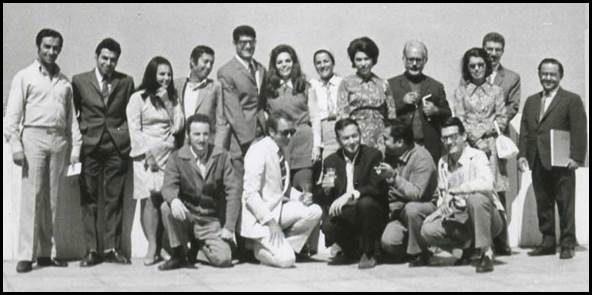
This memorable photograph taken on the roof of adjacent building to Roudaki Hall shows the group of accomplished artists – the pioneers who contributed to the development of the opera in Tehran.
Second row standing from the left: Hossein Sarshar (baritone), Enayat Rezai (director), Mrs Jacqueline de Warren (ballerina) Ahmad Parsi (tenor), Ahmad Pejman (composer), Monir Vakili (soprano), Turan Nikju (soprano), Fakhereh Saba (mezzo soprano), Heinz Sosnitza (conductor), Mrs Ahmad Pejman, Houshang Ostavar (composer), and Hossein Dehlavi (composer);
First row kneeling from the left: Albino Toffoli (tenor), Robert de Warren (choreographer), Jean Paul Richter (chorus master), Leo Luca Mancuso (baritone), and Ferruccio Franceschini (bass)
Tehran Roudaki Hall, October 1967. Photo property of Enayat Rezai
During the nine months long artistic seasons, running from September through June, Roudaki Hall presented an impressive outline of 14-17 operas, including 5-6 new productions. The long list of artists featured renowned Iranians, such as Monir Vakili, Soudabeh Tadjbakhsh, Evelyn Baghtcheban, Pari Samar, Rohangiz Yachmi, Vahideh Fatourechi, Fakhereh Saba, Soudabeh Safaieh, Turan Nikju, Mansoureh Ghasri, Nassrin Azarmi, Farah Afiatpour, Pari Zanganeh, Enayat Rezai, Hossein Sarshar, Ahmad Parsi, and many famous guest soloists to name but a few, such as Cesare Siepi, Tito Gobbi, Giorgio Tozzi, Giuseppe Taddei, Renato Capecchi, Jef Vermeersch, Ugo Benelli, Giovanni Gibin, Lino Puglisi, Pier Miranda Ferraro, Carlo Bini, Guy Chauvet, Vasile Moldoveanu, Nicolae Herlea, Nicola Ghiuselev, Edmund Kossowski, Leonard Mróz, Vicente Sardinero, Michele Casato, Luciana Serra, June Card, Edy Letizia Amedeo, Rita Lantieri, Marcella Reale, Miwako Matsumoto, Maria Candida, Ursula Schrӧder-Feinen, and Debria Brown, amongst others, who came to Tehran from the world’s famous opera houses attracted by the most thriving city in the Middle East.
From 1967, beside his career as an operatic, concert and Lieder singer, Enayat Rezai devoted himself to opera stage direction. His credits at Roudaki Hall include premiered and revival opera productions spanning from the Baroque period to the contemporary. To make opera more attractive to children, young adults and traditional older audience, the company introduced educational and entertainment programs by performing operas originally written in Farsi or translated into Persian-language by Enayat Rezai, Mahmoud Khoshnam and Amir Ashraf Arianpour.
Enayat Rezai Premieres and Revivals at Roudaki Hall
Pergolesi’s La serva Padrona (1968), Donizett’s Don Pasquale (1971), Cimarosa’s The Secret Marriage (1971), Mozart’s Cosi fan tutte (1967, 1968, 1970, 1971, 1973), Mozart’s The Magic Flute (1968, 1973 after 1971 Heinz Arnold), Rossini’s The Barber of Seville (1969, 1973, 1976 production for TV), Prokofiev’s Peter and the Wolf (1971), Ilie Balea’s TheLittle Red Hat (1971), Leoncavallo’s I Pagliacci (1973, 1975), Mascagni’s Cavalleria Rusticana (1968, 1971, 1975), Menotti’s Amahl and the Night Visitors (1972), Menotti’s Help, Help, the Globolinks! (1972), Mussorgsky’s Boris Godunov (1973), Humperdinck’s Hänsel and Gretel (1974, 1975, 1976 production for TV), Orff’s Die Kluge (1973, 1974), Smetana’s The BarteredBride (1976 production for TV); Puccini’s Madama Butterfly (1971, 1975 after 1971 Yoshio Aoyama), Tosca (1969, 1971, 1972, 1974), Turandot (1971, 1974), La Bohème (1970, 1974, 1975), Il Tabarro (1973, 1974), Gianni Schicchi (1973, 1974); Verdi’s Il Trovatore (1969), La Forza del Destino (1971), Rigoletto (1961, 1969, 1971, 1976), and Otello(1974) with Tito Gobbi as Iago, in Enayat Rezai production (after 1973 Federik Mirdita), casting Pier Miranda Ferraro as Otello and Ileana Sinnone as Desdemona, under musical direction of Manrico de Tura, including the special performance in attendance by Their Majesties the Shah and Empress Farah in 1974.
Enayat Rezai Productions of Persian Opera
Ahmad Pejman’s The Peasant Feast(1967), Ahmad Pejman’s The Hero of Sahand (1968), Thomas Christian David’s Atossa (1968), Loris Tjeknavorian’s Pardis and Parisa (1973, 1975), Hossein Dehlavi’s Khosrow and Shirin (1970), depicting the tragic love story of the Sassanian king Khosrow towards the Armenian princess Shirin, based on 12th c. Persian poet, Nizami Ganjavi, featured Hossein Sarshar and Soudabeh Safaieh in the leading roles.
Roudaki Hall Productions Translated into in Farsi
Mozart’s The Marriage of Figaro (1971), Enayat Rezai and Mahmoud Khoshnam
Sergei Prokofiev Peter and the Wolf (1971), Enayat Rezai and Mahmoud Khoshnam
Ilie Balea’s The Little Red Hat (1971), Enayat Rezai and Mahmoud Khoshnam
Humperdinck’s Hänsel and Gretel(1974, 1975), Enayat Rezai translation
Johann Strauss’s The Gypsy Baron(1974), Enayat Rezai and Mahmoud Khoshnam
Menotti’s Amahl and the Night Visitors(1972), Enayat Rezai
Menotti’s Help, Help, the Globolinks!(1972), Mahmoud Khoshnam
Carl Orff’s Die Kluge(1973, 1974), Enayat Rezai and Mahmoud Khoshnam
Britten’s Let’s Make an Opera(1975), Amir Ashraf Arianpour
Enayat Rezai Singing Performances in Farsi
King Kourush (Atossa), Count Almaviva (The Marriage of Figaro), Shapoor (Khosrow and Shirin), Father (Hänsel and Gretel), Dr. Stone (Help, Help, the Globolinks!), King (The Kluge)
Enayat Rezai Singing Performances at Roudaki Hall
Guglielmo (Cosi fan tutte), Don Alfonso (Cosi fan tutte), Rigoletto (Rigoletto), Figaro (The Barber of Seville) Count Robinson (The Secret Marriage), Count Almaviva (The Marriage of Figaro), Papageno (The Magic Flute), Moralès (Carmen), Sharpless (Madama Butterfly), Sacristan (Tosca), Circus Master (The Bartered Bride), and Valentin (Faust) with guest appearances by Cesare Siepi as Méphistophélès, in stage production of Karl Heinz Haberland with Gianluigi Gelmetti on the podium, including the special performance in attendance by Their Majesties the Shah and Empress Farah in 1973.
Selected photos of Enayat Rezai performances
Courtesy of Enayat Rezai
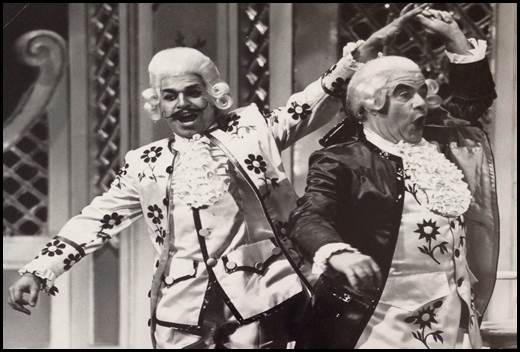
Enayat Rezai as Count Robinson and Fritz Ollendorff as Geronimo in Cimarosa’s The Secret Marriage
The stage production by Enayat Rezai, under the baton of Heinz Sosnitza, featured Soudabeh Safaieh as Elisetta, Luciana Serra as Carolina, Fakhereh Saba as Fidalma, and Alek Melkonian as Paolino.
Roudaki Hall, Tehran, 1971. Photo courtesy of Enayat Rezai
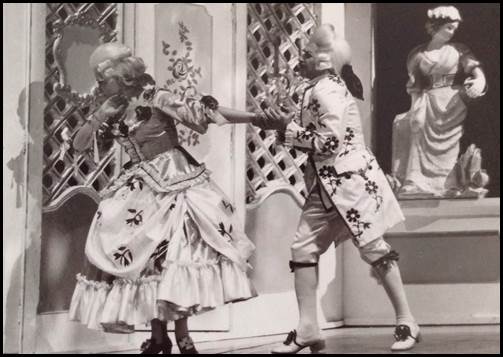
Luciana Serra as Carolina and Enayat Rezai as Count Robinson in Cimarosa’s The Secret Marriage
Roudaki Hall, Tehran, 1971. Photo courtesy of Enayat Rezai
The Roudaki Hall have created a memorable production of Domenico Cimarosa’s The Secret Marriage (Il Matrimonio Segreto) directed by Enayat Rezai with brilliant scenery designed by Theo Lau from Gelsenkirchen, whose sets have become something of a legend and with costumes designed by Helen Ensha (the creative team, who work together from 1967 until 1976, when most of the opera’s old guard had gone, replaced with newcomers). By using wings and plastic costumes that glittered under stage lights, the performance has turned the characters into living figures of porcelain, creating the atmosphere of a world resembling a china-shop full of fragile beauty.
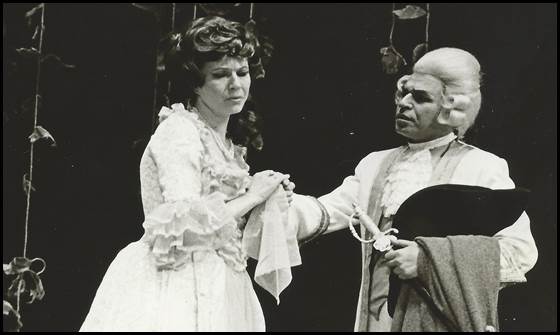
Ingrid Rezai as Fiordiligi and Enayat Rezai as Guglielmo in Mozart’s Cosi fan tutte, 1971
The stage production by Enayat Rezai, under the baton of Petre Sbarcea and Vincenzo Giannini, chorus master, with set/costumes designed by Theo Lau, featured Giovanna Vighi as Dorabella, Linda Pierce-Tjeknavorian as Despina, Alek Melkonian as Ferrando, and Carlo Del Bosco as Don Alfonso.
Roudaki Hall, Tehran, 1973. Photo courtesy of Enayat Rezai
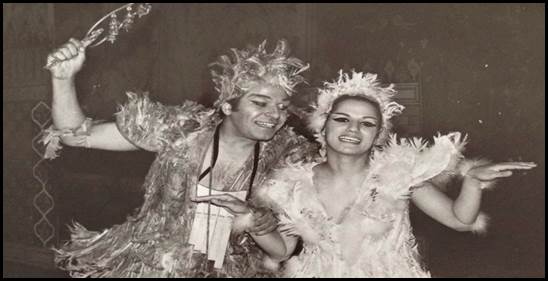
Enayat Rezai as Papageno and Turan Nikju as Papagena in Mozart’s The Magic Flute, 1971
The Magic Flute’s production by Enayat Rezai in 1968 was newly staged in 1971 by Heinz Arnold and repeated in 1973 by Enayat Rezai, after Heinz Arnold with cast that included Monir Vakili as Pamina, Alek Melkonian as Tamino, Aria Zand, Veronica Lacky and Luciana Serra as The Queen of the Night, Enayat Rezai as Papageno, Turan Nikju and Nassrin Azarmi as Papagena, George Pappas, Ferruccio Franceschini, Eduard Wollitz, Arnold Van Mill as Sarastro, Ahmad Parsi and Daniel Goujvin as Monostatos, under the batons of Heinz Sosnitza, Heshmat Sanjari and Farhad Mechkat.
Roudaki Hall, Tehran, 1971. Photo courtesy of Enayat Rezai
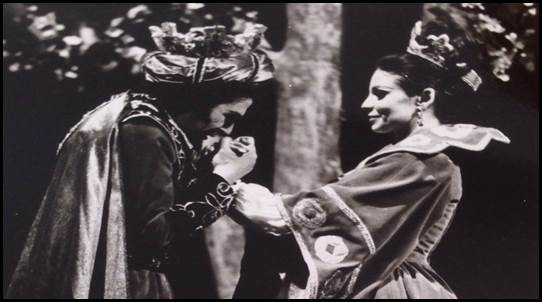
Enayat Rezai as the King and Soudabeh Safaieh as the wise girl in Carl Orff’s Die Kluge, 1974
The fairy-tale opera by Carl Orff staged in Farsi version by Enayat Rezai took place in an imaginary Country of Delight believed to be a Jinnistan where, according to the popular ancient Persian folklore, the fiery spirits, Jinns or Genies lived there and were submitted to the King Salomon. Conducted by talented Farshad Sanjari, in scenery by Abdollah Hadji Ghorbani and costumes designed by Helen Ensha, the cast featured Enayat Rezai as Sultan (the King), Soudabeh Safaieh as Peasant Girl, becoming his Queen, Esfandiar Gharabaghi as Peasant, and Daniel Goujvin as Donkey Owner.
Roudaki Hall, Tehran, 1974. Photo courtesy of Enayat Rezai
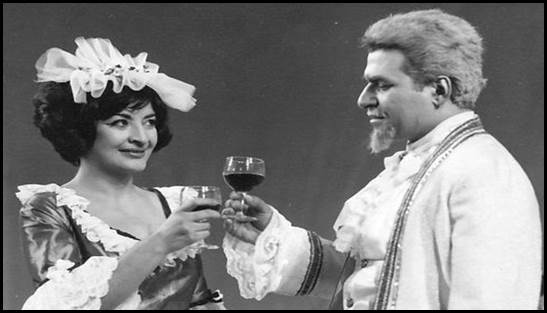
Mansoureh Ghasri as Despina and Enayat Rezai as Don Alfonso in Mozart’s Cosi fan tutte, 1967
On April 18, 1968, Mansoureh Ghasri sang the title role of Atossa, the daughter of Cyrus the Great and the Queen of Persia, opposite Hossein Sarshar as Cyrus the Great in the opera ‘Atossa’, composed by Thomas Christian David, the Austrian composer and privately her husband, based on the libretto by Manouchehr Sheibani in stage direction by Enayat Rezai, conducted by Thomas Christian David.
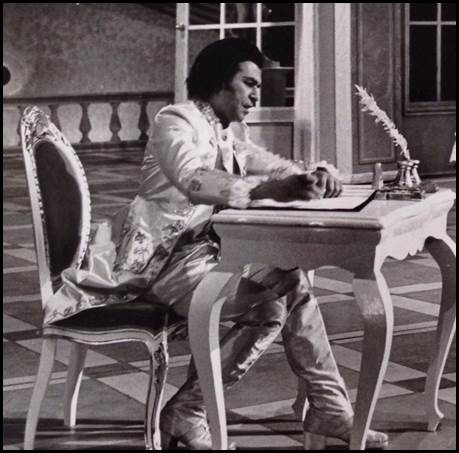
Enayat Rezai as Count Almaviva in Mozart’s Marriage of Figaro, Roudaki Hall, 1971
This finely crafted Mozart production, translated into Farsi by Enayat Rezai and Mahmoud Khoshnam, in stage direction by Ernst-August Schneider, conducted by Friedrich Pleyer (both from Vienna Opera House), with sets by Theo Lau and costumes by Helen Ensha, in choreography by Robert de Warren, featured Monir Vakili as Susanna, Evelyn Baghtcheban as Marcellina, Ingrid Rezai as Countess, Hossein Sarshar as Figaro, Rouben Aghabegians as Bartolo, and Enayat Rezai as Count Almaviva. Roudaki Hall, Tehran 1971. Photo courtesy of Enayat Rezai
In November 1975, Enayat Rezai presented his last staged production in Tehran of “Pardis and Parisa” by Loris Tjeknavorian (1973 revival), under the baton of the composer (then the Composer-in-Residence). The libretto in Farsi written by Mahmoud Khoshnam, based on the story by Parvin Sarlak about two lost children, their dreams, journey, and imagination delighted the children and adults alike with richly orchestrated melodies and varieties of rhythm. The various ballet sequences of doves and different animals, choreographed by Aida Ahmadzadeh highlighted the opera with colorful costumes designed by Helen Ensha.
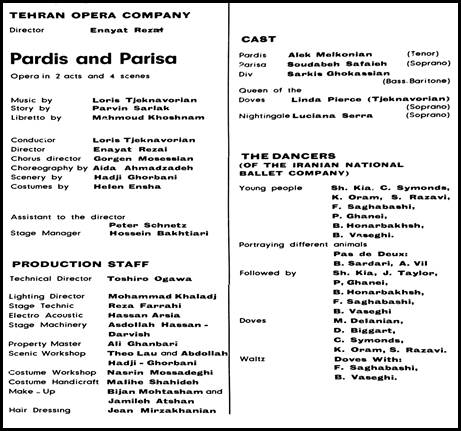
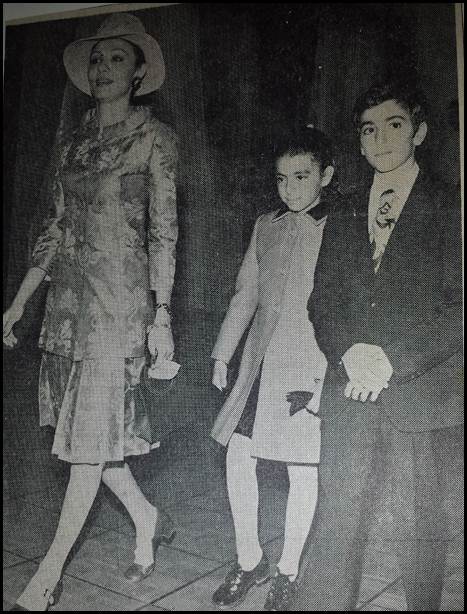
Empress Farah with Prince Reza and Princess Farahnez visiting Tehran Opera
The performance of Loris Tjeknavorian’s Pardis and Parisa at Roudaki Hall, 1975
Source: Farda Persian Newspaper
The 2,000 seats Roudaki Hall (Talar-e Roudaki) has been renamed Talar-e Vahdat, meaning Unity Hall, and until today remains the most important venue used for occasionally presented concerts of Persian traditional, pop and Western classical music, supported by Ministry of Culture and Islamic Guidance in accordance with protecting and conserving Islamic values and music objectives. Despite government restrictions there has been a gradual easement and relaxation of all genres and styles of music. It is worthy to mention the recent theatrical production of Gianni Schicchi, sung in Italian, and the Persian-language adaptations of My Fair Lady, The Sound of Music and Hänsel and Gretel, directed by Austrian-trained Hadi Rosat; these include various concerts of the Tehran Symphony Orchestra performing works of prominent Iranian composers under the baton of maestros Loris Tjeknavorian, Fereydoun Nasseri, Nader Mashayekhi, Shardad Rohani, and first female conductor Nazanin Aghakhani. (The Associated Press often confused the Tehran Symphony Orchestra with Iran’s National Orchestra, Orchestre-e Melli, founded by conductor Farhad Fekhreddini in 1998). Referring to the latest breaking news, in March 2015, the Culture Minister Ali Janneti has appointed the Iranian born, Vienna-based conductor Ali (Alexander) Rahbari as the Artistic Music Director of the Tehran Symphony Orchestra, which is the oldest symphony orchestra with tradition dated back to the 1930s. During the Persian New Year, March 2005, and repeated ten years later, in March 2015, the 150 musicians and choir singers performed the Ninth Symphony by Beethoven attended by the government officials and foreign dignitaries. Maestro Ali Rahbari future projects include the mounting of the production of Puccini’s “Sister Angelica” (Suor Angelica), and of Mozart’s “The Magic Flute”. It remains to be seen whether these ambitious plans would get started and if the role of women, often barred from the stage, may well be rewritten. We shall express hope for opera in Tehran rising from the ashes once again.
(References: The Guardian, April 6, 2015, Tehran Times, July 20, 2015, and Payvand Iran News, August 28, 2015).
During the next fifteen years (from 1974 to 1988), Enayat Rezai built an active and rewarding international career as visiting stage director. His credits include over thirty productions at opera houses in Germany, Spain, Romania, the Netherlands, and South Africa, in Namibia and KwaZulu-Natal, and in Texas, U.S.A.
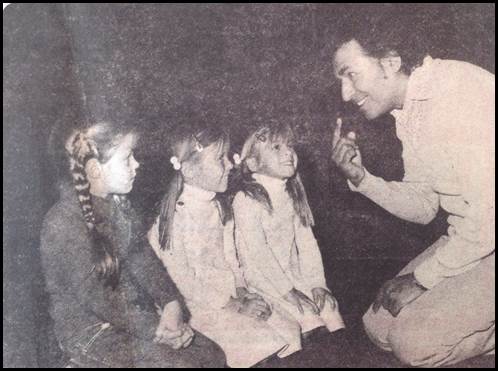
Enayat Rezai rehearses some of the children who will play Dolore (Sorrow), Butterfly’s child
Puccini’s Madama Butterfly in stage production by Enayat Rezai at the Natal Playhouse Opera Theatre, Natal Performing Arts Council (NAPAC), Durban, South Africa, September 13, 1987
Courtesy of Enayat Rezai. Source: The Sunday Tribune, September 13, 1987, Durban, South Africa
Enayat Rezai Opera Productions as Guest Stage Director
January 2, 1974, Mozart’s The Marriage of Figaro, The National Opera Romana, Cluj-Napoca, with Dan Serbae (Figaro), Angela Nemes (Susanna), Vasile Cătană (Count Almaviva), Ana Manciulea (Marcellina), Titus Pauline (Bartolo), Stafen Popescu (Basilio); Petre Sbarcea conductor; Silviu Bogdan set designer
July 10, 1974, Richard Strauss’s Elektra, Stadttheater Passau XXII. Europäische Wochen at Nibelungenhalle, with Ursula Schrӧder-Feinen (Elektra), Astrid Varnay (Klytämnestra), Kay Griffel (Chrysothemis), Heinz Imdahl (Orest), Hebert Becher (Aagisth); Walter Hornsteiner conductor with Bamberger Symphony Orchestra
November 7, 1974, Richard Strauss’s Ariadne auf Naxos, Staatstheater Saarbrücken, with Karen Middleton (Ariadne), Maria Candida (Composer), Elena Marinescu (Zerbinetta), Rudi Horstmann (Majordomo), Dusan Popovic (Music Teacher), Dietmar Kühnel (Bacchus); Christoph Prick conductor
February 2, 1975, Puccini’s Madama Butterly, Stadttheater Osnabrück,with Renate Scheler (Cio-Cio-San), David Bergeson (Pinkerton); Heinz Finger conductor, Edgar Ruth set designer. It was Enayat Rezai first production in German language, repeated in Lünen on April 8, 1975
May 7, 1975, Puccini’s Turandot, NAPAC (Natal Performing Arts Council), Alhambra Theater, Durban, with Lucia Ferraris-Kelston (Turandot), Gé Korsten (Calaf), Nellie du Toit (Liù), Oystein Liltved (Timur); Franco Ferraris conductor with Natal Symphony Orchestra; Theo Lau set designer
May 30, 1975, Puccini’s La Bohème, Theater Trier Opera House, Trier, with Ana Maria Osorio (Mimi), Otoniel Gonzaga (Rodolfo), Franzi Berger (Musetta), James Brookes (Marcello); Charles Van der Zand conductor; Jo Giersch set designer; Hans Swarowsky German translation
June 5, 1975, Mozart’s The Abduction from the Seraglio, Stadttheater Passau, repeated in Heiderberg Schloss, with Ursula Koszut (Konstanze), Renata Holm (Blonde), Rudolf Schock (Belmonte), Oskar Czerwneka (Osmin), Erik Geisen (Pedrillo); Walter Hornsteiner conductor with Die Stuttgarten Philharmoniker
July 1975, Mozart’s Cosi fan tutte, Die Eutiner Festspiele, Eutin (Schleswig-Holstein), with Julie Griffeth (Fiordiligi), Olive Fredericks (Dorabella), Lutz-Michael Harder (Ferrando), Helmut Guhl (Guglielmo), Karl Fäth (Don Alfonso), Noriko Ogura (Despina); Erwin Jamrosy conductor with Hamburg Symphony Orchestra
October 20, 1975, Rossini’s The Barber of Sevile, Staatstheater, Saarbrücken, with Elena Marinescu (Rosina), Roderick Heating (Count Almaviva), Günther Blanke (Figaro), Karl Fäth (Bartolo), Manfred Bertran (Basilio), Maria Candida (Marzelline/Berta); Dieter von Zdunowski conductor
November 24, 1975, Wagner’s Lohengrin, Gran Teatro Del Liceo, Barcelona, with Gerlinde Lorenz (Elsa), Grace Hoffmann (Ortrud), Vojislav Vujacic (Lohengrin), Rolf Kühne (Friedrich of Telramund), Eduard Wollitz (Heinrich der Vogler); Kurt Wӧss conductor with Liceo Orquesta Sinfonica
January 2, 1976, Cimarosa’s The Secret Marriage, Opera House Osnabrück, with Christine Baschung (Elisetta), Erwin Vogt (Geronimo), Karen Melander (Carolina); Peter Starke conductor, translated by Joachim Popelka
February 5, 1976, Verdi’s Rigoletto, Gran Teatro Del Liceo, Barcelona, with Milena Dal Piva (Gilda), Franco Bordoni (Rigoletto), Flaviano Labo/Luciano Soldari (The Duke), Montserrat Aparici (Maddalena), Kurt Rydl (Sparafucile); Eugenio M. Marco conductor with Liceo Orquesta Sinfonica
May 6, 1976, Puccini’s Madama Butterfly, NAPAC, Alhambra Theater, Durban, with Nellie Du Toit (Cio-Cio-San), Luigi Bianco (Pinkerton), Jean Stuart (Suzuki), Kenneth Reynolds (Sharpless); John Pryce-Jones conductor with Durban Symphony Orchestra
July 3, 1976, Cimarosa’s Il Marito Disperato, Theater Trier Opera House, Trier, with Lia Rottier (Gismonda), Ana Maria Osorio (Eugenia), Norico Oguara (Dorina), James Brooks (Carbolone); Jean Francois Monnard conductor
August 11, 1976, Mozart’s Cosi fan tutte, Village Windhoeh Theatre, Windhoek (Namibia), with Ingeborg Schneider (Fiordiligi), Gertrude Jahn (Dorabella), Werner Nel (Guglielmo), Stephen Tuder (Ferrando), Kenneth Reynolds (Don Alfonso), Suzanne Davis (Despina); John Pryce-Jones conductor
December 15, 1976, Donizetti’s L’Elisir d’Amore, Nederlande Reiseopera, Enschede, with David Palmer (Nemorino), Sakiko Kanamori (Adina), Hubert Waber (Dulcamara),Charles van Tassel (Belcore); Arthur Howard Fagen conductor with The Netherlands Symphony Orchestra
March 3, 1977, Puccini’s Tosca, The Fort Worth Opera, Tarrant County, Texas, with Lorna Haywood (Tosca), Barry Morell (Cavaradossi), Willima Justus (Scarpia); Rudolf Kruger conductor
October 5, 1977, Verdi’s Rigoletto, NAPAC, Alhambra Theater, Durban, with Kenneth Reynolds (Rigoletto), Jeanette Harris (Gilda), Luigi Bianco (The Duke), Oystein Liltved (Sparafucile), Renee Rakin (Maddalena); Bijan Setayesh conductor with Durban Symphony Orchestra; Theo Lau set designer
April 17, 1978, Puccini’s Turandot, PACOFS (Performing Arts Council of the Orange Frere State), Opera Civic Theatre, Bloemfontain,with Joyce Barker (Turandot), Renato Cioni (Calaf), Rikie Venter (Liù); conductor Franco Ferraris with the Natal Philharmonic Orchestra; scenery by Theo Lau
July 15, 1978, Donizetti’s Don Pasquale, NAPAC, Alhambra Theater, Durban,with Harold Blackburn (Don Pasquale), Jeanette Harris (Norina), Manuel Escorcio (Ernesto), Lawrence Folley (Malatesta); Leo Quayle conductor with the Symphony Orchestra; Theo Lau set designer, January 30, 1979, Wagner’s The Flying Dutchman, Gran Teatro Del Liceo, Barcelona, with Rudolf Holtenau (The Dutchman), Marita Napier (Senta), Hanz Franzer (Daland), Connel Byrne (Erik); Matthias Aeschbacher conductor with Orquesta Sinfonica Del Gran Teatro Del Liceo
July 15, 1980, Donizetti’s L’Elisir d’Amore, Winston Churchill Theatre, Pietermaritzburg (KwaZulu-Natal), with Yordy Ramiro (Nemorino), Virginia Oosthuizen (Adina), Dawie Couzyn (Dulcamara), Werner Nel (Belcore), Irene Hucks (Gianetta); Leo Quayle conductor
July 25, 1981, Puccini’s Madama Butterfly, NAPAC, Alhambra Theatre, Durban, with Luisa Bosabalian (Cio-Cio-San), Yordy Ramiro (Pinkerton); Sarita Stern (Suzuki), Kenneth Reynolds (Sharpless), Oystein Liltved (Bonze), Enayat Rezai (Goro); Alun Francis conductor
July 6, 1982, Verdi’s Rigoletto, NAPAC, Alhambra Theater, Durban, with Hans van Heerden (Rigoletto), Eugenie Chopin-Couzyn (Gilda), Yordy Ramiro (The Duke), Oystein Liltved (Sparafucile), Evelyn Dalberg (Maddalena), Davie Couzyn (Count Monterone), Enayat Rezai (Borsa); Alun Francis conductor with NAPAC Symphony Orchestra
March 15, 1983, Smetana’s The Bartered Bride, PACOFS Civic Theater, Bloemfontain, with Eliza Botha (Marenka), Michael Renier (Janik), Oystein Liltved (Kecal), Hans van Heerden (Krusina), Jean Stuart (Ludmila), Enayat Rezai (Vasek/tenor part); Gerhard Geist conductor
June 30, 1983, Smetana’s The Bartered Bride, NAPAC, Alhambra Theater, Durban, with Eugenie Chopin-Couzyn (Marenka), Michael Renier (Janik), Lawrence Richard (Kecal), Hans van Heerden (Krusina), Jean Stuart (Ludmila), Enayat Rezai (Vasek/tenor part); Alun Francis conductor with NAPAC Symphony Orchestra
April 17, 1984, Verdi’s Otello, PACOFS, Civic Theater, Bloemfontain, with Renato Francesconi (Otello), Eugenie Chopin-Couzyn (Desdemona), Hans van Heerden (Iago), Jean Stuart (Emilia), Enayat Rezai (Rodrigo), Michael Renier (Cassio); Gerhard Geist conductor
August 30, 1984, Cavalleria Rusticana/I Pagliacci, NAPAC, The Natal Playhouse Opera Theater Durban, with Evelyn Dalberg (Santuzza), Micheal Renier (Turiddu), Esthé van Wyk (Nedda), Josef Becher (Canio); Alun Francis conductor with the Natal Philharmonic Orchestra
September 13, 1986, Verdi’s La Traviata, NAPAC, The Playhouse Opera Theater, Durban, with Eugenie Chopin-Couzyn (Violetta), Yordi Ramiro (Alfredo), Dawie Couzyn (Giorgio Germont); David Titboald conductor with the Natal Philharmonic Orchestra
May 16, 1987, Offenbach’s The Tales of Hoffmann, PACOFS, Sand Du Plessis Theatre, Bloemfontain, with Eugenie Chopin-Couzyn (Olympia, Antonia, Giulietta, Stella), Horst Hoffmann (Hoffmann), Hans van Heerden (Lindorf, Coppélius, Miracle, Dapertutto), Merilyn Bennet (Nicklausse); Gerhard Geist conductor; Enayat Rezai set and costume designer
August 16, 1987, Puccini’s Turandot, NAPAC, The Natal Playhouse Opera Theater, Durban,with Marita Napier (Turandot), Giorgio Tieppo (Calaf), Rikie Venter (Liù); David Titboald conductor with the Natal Philharmonic Orchestra
September 13, 1987, Puccini’s Madama Butterly, NAPAC, The Natal Playhouse Durban, with Rikie Venter (Cio-Cio-San), Giorgio Tieppo (Pinkerton), Sally Presant (Suzuki), Bob Bobrowsky (Sharpless), Oystein Liltved (Bonze), Brian Miller (Goro), Linda Bukhosini (Kate Pinkerton), Melanie Ashdown as Butterfly’s child (Dolore); Leo Quayle and Graham Scott conductors with the Natal Philharmonic Orchestra
September 10, 1988, Gounod’s Faust, NAPAC, The Natal Playhouse Opera Theater, Durban, with Riccardo Calleo (Faust), Oystein Liltved (Méphistophélès), Eugenie Chopin-Couzyn (Marguerite), Michael Halliwell (Valentin); Professor Leo Quayle conductor with the Natal Philharmonic Orchestra
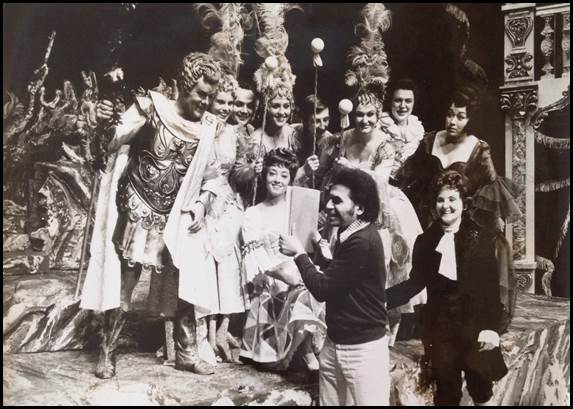
Richard Strauss’s Ariadne auf Naxos, Staatstheater Saarbrücken, November 7, 1974
Enayat Rezai during dress rehearsal surrounded by soloists with Maria Candida as Composer (standing right beside) and Dietmar Kühnel as Bacchus (at top left). Photo courtesy of Enayat Rezai
At the beginning of the 1990s, Enayat Rezai, who received countless accolades, had ended his artistic activities. During decades of professional life, he brought to the stage his remarkable talents and always skillfully crafted his staging intentions for more than sixty opera productions, which bore his personal stamp. Especially the imaginative and lavish productions of Puccini’s “Turandot”, inspired by the original story of Persian princess Turan-Dokht from the romantic epic “The Seven Beauties” (Haft Peyhar) by poet Nizami Ganjavi, turned out to be mostly hailed by critics. After the Tehran premiere of “Turandot” on January 10, 1971, with Soudabeh Tadjbakshs (Turandot), Nicola Martinucci (Calaf), and Monir Vakili (Liù), under the baton of Manrico de Tura, the Tehran Journal summoned: “Drop everything to see this”. A few years later in South Africa, the performances of “Turandot” received top marks by critics while the public reacted with enthusiasm. The 1978 and 1987 newspaper reviews highlighted: “Turandot was a Triumph”, “Turandot is a Dazzler”, “Nobody should miss it”, “Sparks and Sparkle in Turandot”, and “Turandot Skouspelagtig en Treffend”.
Among his honors, Enayat Rezai is the recipient of the greatly esteemed Homayoun Gold Medal for his artistic achievements and for his decisive role in establishment of the opera in Iran, and of the Silver Medal commemorating the 2,500th Anniversary of the Persian Empire.
Today, a retired opera director and retired singer with warm baritone voice, and a book-lover and the owner of a bookstore in Bavaria, he lives a happy and healthy life. Finally, he is happy that his career was just what he wanted it to be, remembering the little boy in Manama, and his early childhood dreams to be an artist. And then, one day on his journey returning home, to teach and to inspire young artists and opera adepts in Bahrain, we shall see what destiny has in store for him.
We wish Director Enayat Rezai many happy and healthy years to come and to celebrate.

Enayat Rezai in recent years
Photo property of Liliana Osses Adams
In my acknowledgment, grateful for our friendship, I wish to thank Enayat Rezai for his responses to my queries and willingness to share with me his exclusive collection of materials and photographs resulting in this work, which, without his amazing assistance wouldn’t have been possible, and which, I dedicate to his two daughters, Susan and Parwin.
© Liliana Osses Adams
California, June - December, 2015
Proofreading by Bruce Adams. Authorized by Enayat Rezai
All rights reserved. Reproduction of any part of these pages, either text or photographs is strictly forbidden without the author’s consent or without prior written permission.
harpliliana@comcast.net
Please listen to downloads of Italian baritones, masters and teachers, Apollo Granforte (1886-1975), Carlo Galeffi (1884-1961), and Mario Basiola (1892-1965) in Leoncavallo’s Pagliacci – Prologue, and to the rare sound clip of Evelyn Baghtcheban (1921-2010), in a live rendition of Stride la vampa from Verdi’s Il Trovatore atRoudaki Hall
Apollo Granforte – Si può? (Pagliacci) click here to listen
Carlo Galeffi – Si può? (Pagliacci) click here to listen
Mario Basiola – Si può? (Pagliacci) click here to listen
Evelyn Baghtcheban as Azucena in Stride la vampa, April 10, 1969
The Roudaki Hall stage production by Enayat Rezai of Verdi’s Il Trovatore featured Soudabeh Tadjbakhsh (Leonora), Evelyn Baghtcheban (Azucena), Carlo Piccini (Manrico), Hossein Sarshar (Count di Luna), and George Pappas (Ferrando), under the baton of Heinz Sosnitza with the Tehran Symphony Orchestra
For those interested please scroll down for further reading:
“The Forgotten Theatre in the Heart of Asia” by Alexander Matusevich, Opera News Russia, November 24, 2013 (in Russian)
“Top opera artist in major Bahrain push”, Trade Arabia News, Manama, July 15, 2015 (contains a few discrepancies)